Where and When to Go



THERE IS REASON enough to be charmed by Latin America’s tropics. Jungle rivers harbor muscle-bound Dorado and powerful Peacock Bass that will rip a fly rod out of your hands. Mesomorphic Pacu, fanged Payara, gargantuan Arapaima and savage tigerfish will test your skill level, demand new fly fishing tools, and challenge your stamina. In fact, the rivers of the Amazon shelter more species of fish than the entire Atlantic Ocean, and the biggest and baddest of them are targetable with a fly!
Each of the destinations in this magazine is intended to introduce you to more than just another fishing trip. Every spot is a world-class angling adventure.

The following pages are an exposé of spectacular freshwater fly fishing experiences surrounded by exotic jungle and bathed in tropical climate. Every action-packed day at these places is a real-life National Geographic event choreographed by Mother Nature at her most sensuous. They are filled with spectacular scenery, exotic birds, fish, and wildlife, and both days and nights are highlighted by a soundtrack right out of an Indiana Jones movie.
Yes, I’m addicted.
– Mike MichalakWith rivers that are full of powerful, exotic species of sportfish that are as mean as they look and more likely to tear the rod right out of your hands than allow themselves to be landed. As well, jungle adventures expose us to new cultures, and an opportunity to engage indigenous peoples whose passion for their families, way of life, and territories are as fierce as the fish that swim in their waters.
– Mike MichalakWe’ve been to every single one of these places and are confident that they rate among the finest jungle destinations in the world of fly fishing travel. Each carries our total endorsement, along with our iron-clad guarantee that the quality of the experience will be exactly as advertised.
4-7 The Thrill of the Jungle
All about Peacock Bass
8-19 The Amazing Jungle Fisheries of Brazil’s Amazon
20-23 Colombia
Affordable Jungle Fishing
24-31 Bolivia Jungle Fly Fishing Adventures

The most unique dorado fisheries in the world
32-33 The Kayapó Nation Defenders of the Jungle
34-39 Argentina’s Dorado Fisheries
Great trip extensions to Patagonia trout
42-44 Tanzania & Cameroon Tigerfish, Nile Perch and Game Safaris
45-46 Essential jungle fishing gear
No fluff – the gear you need to bring to the jungle
47 Expanding your jungle adventure
Great eco-tours for angling couples
REMEMBER the difficult lessons learned during the pandemic. It’s never been more important to have a travel professional in your corner when planning any angling holiday, and there’s no outfit in the sport you can trust more than The Fly Shop® to ensure you get all the help you’ll need!
You can’t book a trip to any fly fishing destination in the world for less than you can through The Fly Shop®.
The Fly Shop® has been part of the cutting edge of jungle angling for more than two decades. We’re the exclusive agent for the #1 Peacock Bass destination in the Amazon and The Fly Shop® is, arguably, the most experienced and knowledgeable fly fishing travel agent in the entire jungle world.

THEAMAZONRAINFOREST is huge, blanketing nine South American nations with 390 billion trees. Its river system springs to life in the Andes, gathering strength from a spider web of tributaries in Colombia, Bolivia and Peru before massing in Brazil. This huge river network eventually embraces 25% of all the freshwater on the face of the Earth, and has more species of fish than the entire Atlantic Ocean. This is the beating heart of jungle fly fishing.
But don’t forget about the jungle fisheries on the other side of the pond, in the vast wilderness of Africa! It’s another world over there. Predictably, the equatorial belt in Africa is very similar in many regards to that of South America, but the two ecosystem’s have evolved completely isolated from each other, with totally different flora and fauna…and fish!
It is no small wonder that jungle rivers have become the last frontier in fly fishing.
 The jungle is where it’s happening!
Marcos Hlace photo
Matt Harris photo
Daniel Coimbra photo
Daniel Coimbra photo
Val Atkinson photo
Val Atkinson photo
Frank Azevedo photo
Camilo Duarte photo
Avi Hesterman photo
Justin Miller photo
The jungle is where it’s happening!
Marcos Hlace photo
Matt Harris photo
Daniel Coimbra photo
Daniel Coimbra photo
Val Atkinson photo
Val Atkinson photo
Frank Azevedo photo
Camilo Duarte photo
Avi Hesterman photo
Justin Miller photo
There are 16 different species of peacock bass native to the world’s jungles, and none of them are even bass at all! They’re actually the largest and most powerful variety of more than 1,700 species of cichlids, jumbo-size relatives of those small, dazzling fish found in most freshwater aquariums.
INENGLISH they’re called peacock bass. In Brazil’s national language, Portuguese, they are called tucanaré. Tucunaré is a Tupy (native Brazil tribe) word that means ‘friend of the tree’ – no doubt because Peacock bass are commonly found lying near submerged trees either as ambush spots, protection, or as a nesting area. In neighboring, Spanish-speaking Venezuela and Colombia they’re called Pavon, which translates to peacock.
These fish live 6 to 9 years in the wild and only one variety of peacock bass (Cichla temensis) routinely grows into the doubledigit category. Their diet consists mostly of smaller fish, including each other, and as they grow the big fish become progressively less common. So, peacock bass over 10 pounds are considered fish worth getting excited about! Those weighing in the ‘teens’ are considered true trophies, and any serious peacock bass angler would crawl naked through broken glass to connect with a monster that tips the scales near 20 pounds. Temensis (big ones) are usually found in pairs or singles. The largest recorded peacock ever caught was just under 30 pounds. Temensis come in 2 color phases. Asu are the brightly-colored fish that are in spawning mode, and the Paca color phase is dark brown with small white dots in rows along their flanks.
Their smaller (but much more numerous) cousins range in size from 3 to 8 pounds as adults and are called “butterflies” or Borboletta in Portuguese. Though some cohabit with the much larger tucanaré, they’re usually found together in similar-sized family schools, and in often astonishing numbers.

It’s not unusual to hook dozens upon dozens of the smaller variety in a day. But don’t be fooled. What these smaller models lack in size is more than compensated by their aggression, aerobatics, strength, and willingness to attack surface flies.
These ultra-abundant peacocks will bend a 7-weight to the butt, and are an acid test for tippet and tackle.
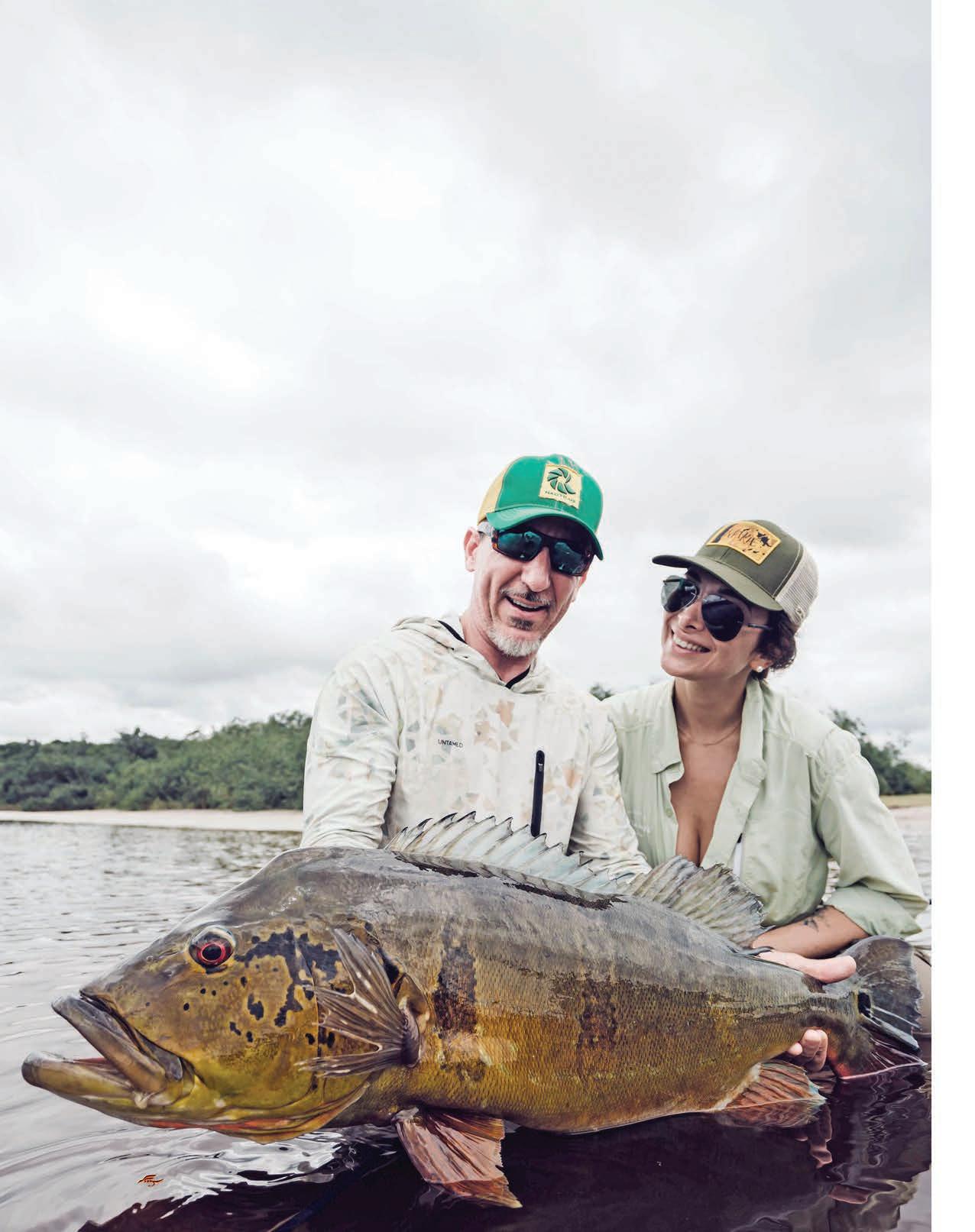
MOSTPEACOCKBASS fishing is located in Brazil, for no other reason than there is just so much more of it located there. Headwaters of the massive spiderweb of the Amazon’s tributaries often begin in Colombia and Venezuela, even as far away as Ecuador, Peru, and Bolivia. Eventually the river system combines to account for nearly 25% of all the fresh water on Earth before pouring into the Atlantic.
Most of the major rivers of Brazil are huge, and able to absorb an enormous amount of commercial domestic netting along with the less threatening international sportfishing pressure applied by the dozens of luxury liveaboard fishing vessels and peacock bass lodges that are spread throughout the entire Amazon and Rio Negro watershed. Brazil’s Ministry of Tourism estimates that more than 18,000 Yankees and other foreign anglers pour into Brazil every season to test their skill and try their luck fishing for peacock bass.
Recognizing that sportfishing is very popular and important to Brazil’s tourism economy, the country’s fisheries biologists began a combination of study and angling conservation more than a decade ago. Brazil’s Institute of Environment and Renewable Natural Resources ( IBAMA ) has conducted intensive biological studies on most river systems and taken progressive steps meant to protect the resource.
More about Peacock Bass
Professor Paul Reiss of Rutgers University, the recently retired founder of Acute Angling (an angling travel company focused on conventional tackle fishing in the tropics) explains:
“Amazon peacocks live in the most pristine and exotic habitats on earth. Jungle lined blackwater rivers, hidden lagoons and white-sand scalloped beaches are just some of the spectacular settings in their native environment. The alien-appearing, isolated still waters lend a counterpoint to their sudden, violent and explosive attacks.”
Both male and female peacock bass have slanting foreheads with an elongated body and a large mouth with a protruding lower jaw – a shape that aids in capturing its prey.
The fish (in all sizes ) are incredibly fast and powerful, with a muscular body and fins that are a mix of yellows, greens, light red, and orange. Normally, they’re olive-green on the back, gradually fading to a yellow-orange or even white towards the underside.
The common characteristic peacocks share are three vertical black lines along their sides, which fade as they mature. They may have several dark splotches on their sides, and larger adults may have a yellow-orange stripe from their snout to the base of the tail. Some varieties feature dark rosettes instead of stripes, or light speckles, while others sport impressive shades of green, orange, blue, gold or dark lateral bands. All have a black spot or ocellus with a yellow or silver border on their rounded caudal fin resembling peacock feathers.
Pound-for-pound, peacock bass are stronger fighting fish than largemouth bass. In fact, big bucket-mouths are notoriously lethargic. Conversely, the bigger a peacock bass grows, the tougher it is to land. And the difference between a big largemouth and a big peacock bass is like the difference between Conan O’Brien and Conor McGregor.
Colors intensify during spawning seasons, and vary with each of the individual fish and variety. Equally captivating are the unique and distinct markings on the gill plates of sexually mature fish. All are as different as our own fingerprints.
It was long thought that coloration differences of the big peacocks indicated many different varieties. However, Reiss and his associates from Rutgers University and Manaus have proven that among the Tucunaré (temensis ), speckled and three-barred fish are all one and the same creature.
In truth, all of them are (or begin as ) speckled peacock bass. Then, as they sexually mature and approach the spawning season in their particular drainage (usually coinciding with the wet season ) the spots begin to disappear and the three bars on their sides become more obvious. Ultra-bright coloration will remain for several months through the nesting season and continue as long as the pair guards and protects their young.
Scientists know that color can have a biological value and impact. Brightly-colored three-bar fish may be more attractive to potential mates. The common spot on their tail (which gives them their name ) might ward off attack from the rear. Bright colors in the wild also indicate toxicity, and the brilliant colors of fry-guarding or nesting fish may be a warning to others that there’s a risk in coming close to infants or eggs.
Most peacocks spawn near the end of the dry season when low water levels make more spawning area available. However, not all spawn at the same time and different spots have different relative depths, so you’ll likely see all of the coloration stages during a typical fishing trip. Some of them are spectacular and anglers often find simultaneous characteristics of speckled and three-bar markings in the fish caught.
The largest of the varieties of peacocks are the Tucunaré (temensis ), alternately known as the speckled, three-barred, or giant peacock bass and the large fish have earned the reputation as one of freshwater’s most powerful and challenging game fish.They’re native to Brazil’s Rio Negro, Rio Branco, the lower Rio Madeira basins and found in the Orinoco and upper Rio Negro drainages in Venezuela and Colombia.
The dozen or so other species of peacock bass are found in remarkably different terrain than the lowland, warm water typical of the Rio Negro drainage tucunaré and butterflies.
Unlike the temensis, which are most always found in singles and pairs, butterflies are schooling fish, and congregate as a family unit. When you come upon a bunch of them, they’ll usually all be the same size. Most of the time they travel and hunt as a pack and, it is thought, butterfly peacocks may find safety and security in their own numbers.
At the other, darker color extreme, nonspawning fish are busy going about the business of fattening up for the long fast associated with spawning. Too, they need to hunt effectively in the dark, flooded forests bordering the Amazon lagoons and backwaters, particularly during the wet season.
The color differences are so pronounced that the fish go by different names among the natives, and anglers; “açu” and “paca” in Brazil - the “speckled" and “three-bar" in English-speaking fishing communities.
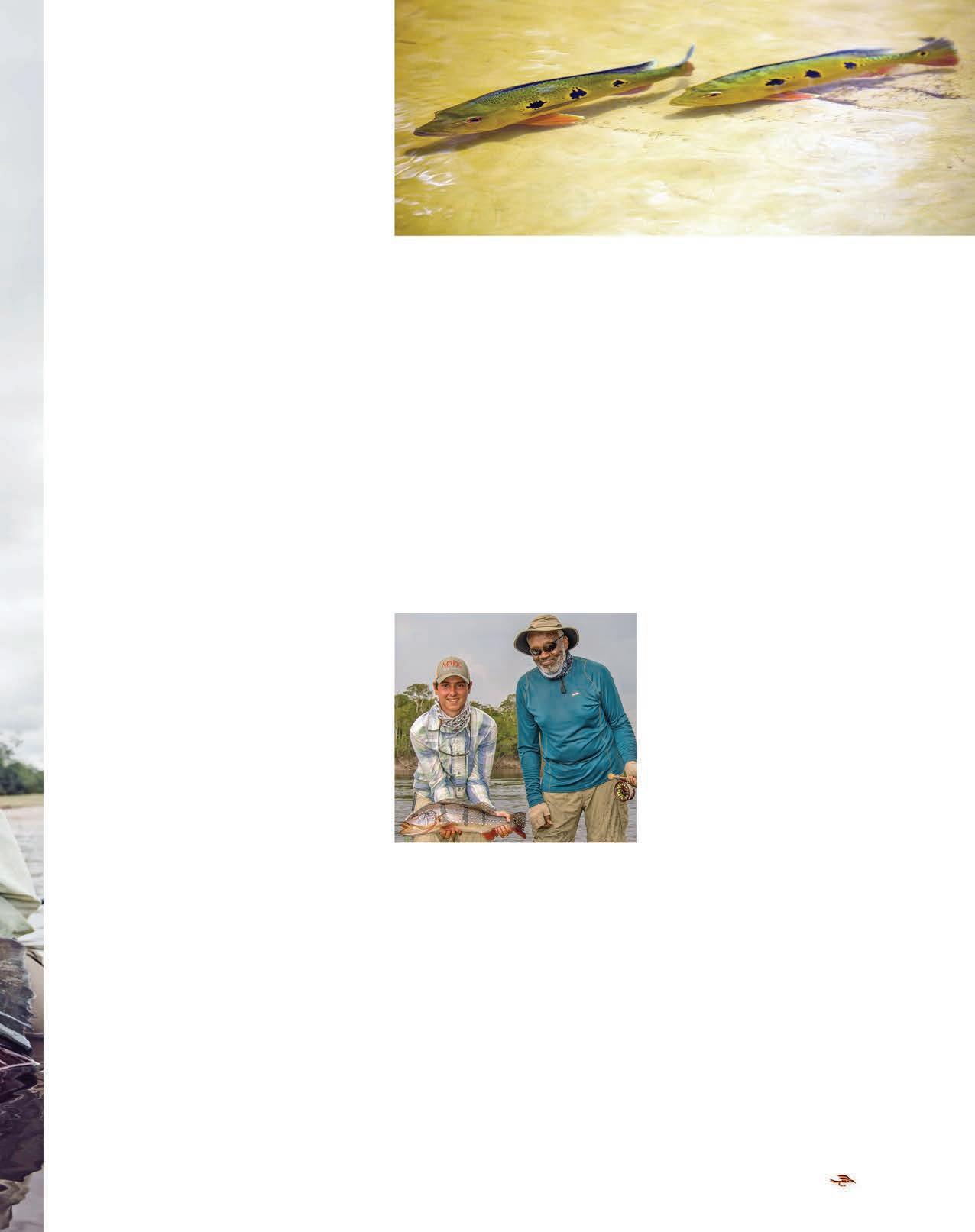
It is speculated that geographic isolation, and colder or swift water might explain the startling differences in coloration between the breathtaking beauty of royal peacock bass (Cichla intermedia ) or the near-neon coloration of the yellow peacock bass found in crystal clear rivers of the Kayapó territory.
They do separate into pairs to spawn, and like their larger cousins, are most aggressive to a fly when protecting their nest or their young.
Peacocks are known to feed exclusively during the day, live up to 6-10 years, and are voracious predators. In ideal conditions these fish can add up to 1.5 pounds in weight for every extra inch of growth. After birth, peacock bass grow very quickly. At times they can grow more than a foot in less than a year and a half. One study in Guyana demonstrated that some peacock bass grow 1.6 inches each month during their first year.
Peacock bass are a fairly sturdy fish, so catch and release survival rates are quite high if the fish are handled correctly and single, barbless hooks are used. They have sandpaper-like mouths similar to that of a largemouth bass, so they can easily be handled by the lower jaw, using the same thumband-finger grip.
THEMARIÉ IS UNIQUE , even in sparsely populated Brazil. It is one of only two rivers in a country larger than the Lower 48 that are managed exclusively as catch-and-release, “fly fishing only” fisheries. It is a first-class, exclusive, off the grid angling experience in the midst of one of the finest peacock bass fisheries on the planet, where the other best rivers are often shared by half a dozen liveaboards and a few lodges stuffed with conventional tackle fishermen.
Under the watchful eye of the Brazilian government’s version of the BIA and their biologists, a historic agreement between the indigenous native tribe (whose territory surrounds the Marié watershed) and our friends at Untamed Angling created what is now the largest fly-fishing-only preserve on planet Earth. Simply explained, only a dozen anglers a week are allowed to fish more than 480 miles of a river – proven to be the number one producing trophy peacock bass destination in the world – each season.
These two magnificent Rio Marié peacock bass weighed 23.5 and 21 pounds respectively, and surely represent what is probably one of the largest fly caught, double hook-ups in history!
Each week this Amazon angling adventure begins with the mothership anchored in a fresh location. There’s no competition, and with hundreds of miles of fish-filled river, the floating palace and its anglers are able to move daily to new fishing grounds, a fresh supply of trophy peacocks, and the prospect of fish that haven’t been molested by any other anglers. Few, other than the local natives, have explored the spider web of tributaries or investigated the labyrinth of oxbow lagoons that nurse this incredible fishery.

These fish haven’t been pounded by lures and woodchoppers, or beat up by treble hooks. In fact, until a decade ago, fewer than 4 dozen fishermen had ever been allowed by the native community to fish the river.
Rio Marié fish act like they’ve never seen an angler before because they probably haven’t.

FLY FISHERMENDEFINITELY have the edge right now when it comes to peacock bass, because the two best rivers in Brazil (Rio Marié and Agua Boa) are now managed as fly fishing only and catchand-release. Nearly half of those who have fished the Marié since the indigenous natives opened the door to sport fishing have hooked and landed a peacock bass over 20 pounds.
The whole Marié experience is over-the-top. The fishing is beyond fantastic; the tropical environment is breathtaking; the mothership accommodations are deluxe; and the service is beyond criticism.
This is one of our Signature Destinations and available exclusively through The Fly Shop® and our professional angling agent network.

Anglers aboard the mobile Marié mothership, “Untamed Amazon”, are greeted each morning with new water to fish. They taxi in pairs to their daily fishing beats in powerful, custom-crafted, outboard skiffs designed for fly fishing the Amazon and manned by sharp-eyed native boatmen and expert, fly-savvy, English-speaking guides. Each successive day they enjoy a constantly replenished supply of naive trophy peacock bass, and the promise of fishing a portion of river that hasn’t recently been pounded.
The Rio Marié is the most distant sport fishery in the entire Amazon basin. Its seldomseen headwaters are more than 500 air miles northwest of Manaus in an impenetrable rainforest near the border separating Brazil from Colombia. There are no nearby roads, and no airstrips. The only viable way to get there is by amphibious float plane. The scenic, three-hour flight from Manaus to the mothership leaves early in the morning, and covers nearly 350 nautical miles, all of it above a pristine, uninhabited jungle
The 2024 rate includes overnight accommodations in Manaus prior to the round trip flight to the river. The operation offers exceptional standards of service, superb accommodations, and excellent cuisine. Packages include all beverages and wine, beer and spirits.
s 7-day package $7,980 Late August through November
s Not included is the $710 mandatory trespass fee required by the Native Association.

THESEAREMONSTERFISH that often weigh hundreds of pounds and are protected in all but two fisheries in Brazil and Guyana. Sight-fishing for arapaima, the largest scaled freshwater fish in the world (up to 9´ long and 440 pounds) is way up near the top of the list of new jungle angling experiences. These colorful, powerful monsters lay in ambush on the bottom of the river, hunting unsuspecting baitfish. They may also cruise into the shallows as singles, in pairs, or even schools. They are actually air breathers and must surface every 40 minutes to gulp fresh air, so if they are
there, you’ll see them splashing as they take a gulp and kick back down towards the bottom. Searching these lakes, channels and rivers is much like hunting flats and mangroves for rolling tarpon. When mature, they’re big and have no known predators. When hooked they go ballistic, obviously pissed off that anything would challenge their alpha role. More than just big, arapaima are strong and their battle is usually punctuated by repeated jumps and powerful runs.
Mamirauá is a huge Brazilian wetland and flooded forest in the heart of the Amazon. This maze of interconnected lakes and lagoons is a World Heritage Site, a national treasure where a vibrant population of arapaima share their jungle habitat with arowana, tambaqui, peacock bass, red-bellied piranha, and oscars. All of them will attack a fly with abandon and add up to a recipe for a diverse and exciting angling holiday.
In our numerous trips to Pirarucú, giant arapaima have been landed up to 330 pounds. The total number of juveniles tipping the scales between 20 to 60 pounds was impressive, and every angler this past season scored and scored big.
There’s daily flight service to Manaus and this package marries perfectly with the charter flight trips to and from the Rio Marié, which stop briefly in Tefé on their return flight to Manaus for re-fueling at the regional airport.
pirarucu lodge
The Mamirauá Reserve is the largest forest reserve in Brazil dedicated exclusively to the protection of the Amazon floodplain.
Covering more than 2.5 million acres, it is home to an indigenous Indian tribe which allows limited catch and release sportfishing in their huge government protected wetland. With the help of professional fisheries biologists, the natives also monitor the wild population of arapaima.
THEPIRARUCUFLOATINGLODGE is located in the heart of a maze of beautiful, breathtaking creek-connected lagoons. Pirarucú is rated as one of the top five birding locations in the Amazon, and fly fishing guests share comfortable lodge accommodations with an interesting multinational collection of eco-tourists and bird watchers.
September through November is the best time to sample the fishing in this vast Amazon reserve. Fly fishing guides are amazingly good, arapaima fishing is action-packed, and the native indigenous staff add a fascinating cultural accent. Guests are serenaded to sleep each night by the sounds of the forest, and awakened early each morning by howler monkeys and a cacophony of the feathered inhabitants of the surrounding refuge and National Parkland.
Floatplane flights returning to Manaus from the Rio Marié re-fuel near Pirarucú, making these easy and convenient packages to combine.
s Fishing package $3,750 - $6,400 2024 Rate
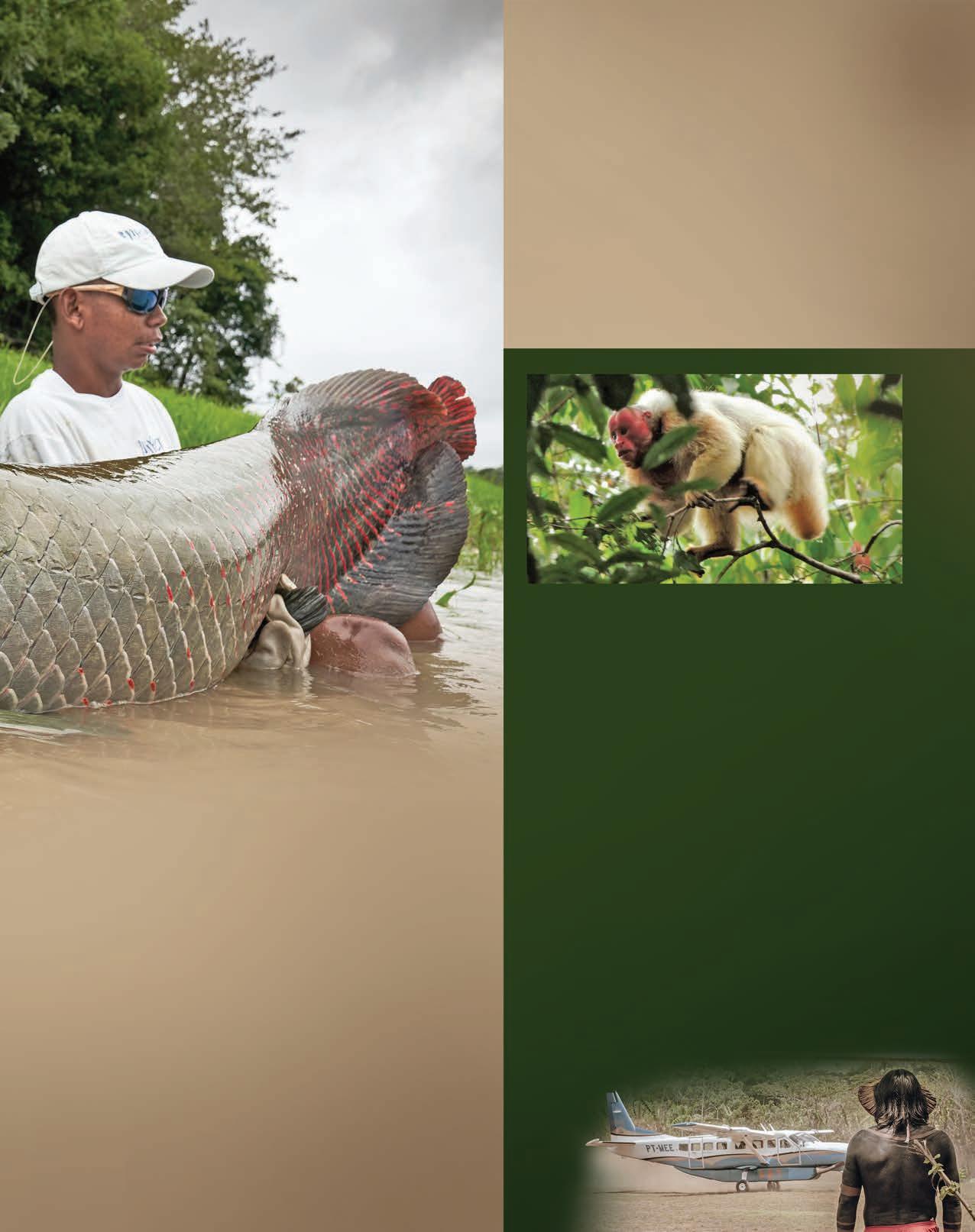
Not included is the Native fee, 10% of trip cost.
A TRIP TO BRAZIL is the perfect holiday for non-anglers and couples looking for an exotic adventure. Every jungle-day is a visual and audible odyssey, a chance to experience one of the greatest ecological wonders in the world – the Amazon. It’s a naturalist’s Shangri La, home to 427 mammals, 1,300 birds, 378 reptiles, and more than 400 species of amphibians.
The Mamirauá Reserve alone, where Pirarucú is located, is home to approximately 400 species of birds, at least 45 species of mammals and 300 species of fish. It’s also a stronghold to the spectacularly strange White Uacari Cacajao calvus, a New World monkey that is bushy and white in color, with a very short tail, bright crimson face and bald head.
The jungle destinations of Kendjam, Xingu, Rio Marié, and Pirarucú allow guests a fascinating glimpse into the life of indigenous tribes, their unique culture and ceremonies. Guests are encouraged to participate in ceremonies such as the Kayapó body painting, an ancient ritual symbolizing strength, vitality and protection ( see page 41). This is genuine adventure travel, a total immersion into the jungle way of life.
Kendjam means “Standing Stone” for the 800-foot mountain of stone towering 800 feet above the forest canopy, it’s a startling landscape feature and very unique in nature. A crystal-clear fly fishing jungle jackpot loaded with exotic varieties of peacock bass that share the pools, riffles, and runs with eight other red-hot river targets!

The Iriri River is a shallow, 800-mile long, fast moving freestone river that courses over a granite and boulder streambed and runs absolutely transparent. It’s a one-of-a-kind Brazilian fishery filled with fly-friendly gamefish, including seldom-seen and less frequently caught varieties of spectacularly-colored peacock bass, wolffish, matrinxa, pacu, bicuda, payara, and more. The Iriri is a wet-wading, sight-casting, fly fishing experience in what amounts to an enormous, clear tropical aquarium in the middle of the Amazon basin.
Kendjam Lodge is typical of other Untamed Angling destinations, reverently carved out of the jungle, situated on a beach overlooking a magnificent view of the fishery, staffed by a combination of indigenous guides and English-speaking pro angling experts. The food is superb, and the comfortable accommodations are a stark contrast to the surrounding rainforest.
GETTING TO KENDJAM is a near all-day affair. Anglers usually arrive in Manaus, Brazil, the night preceding the early morning, 3-hour charter flight to the remote grass airstrip in the heart of the Kayapo’s 26 million-acre territory. From there it’s another 3-4 hours downriver in modern cayugas to the lodge, a journey involving several portages past terraced rapids.
No other anglers share the crystal-clear fishery, and nobody enters the Kayapó territory without being invited.
The Kayapó’s miraculous emergence into the 21st century with their land, culture, and largely subsistence based lifestyle is one of the indigenous culture’s greatest success stories. Kendjam was a deliberate move by the tribe to break away from an existing band in an effort to create a village free of the influence of alcohol and the timber and gold industries. Their connection to tradition and the natural world upon which they depend remains continuous and unbroken. Their chief, Pukatire, was quoted as saying, “We only need the white man for three things. Eyeglasses, flip-flops, and flashlights.”
Part of the Kendjam experience involves some amazing fishing. It also incorporates a fascinating and rewarding cultural facet that rates beyond exceptional. This is a great jungle angling adventure tailored for traveling anglers interested in more than just great jungle fly fishing.
The 2024 rate includes overnight accommodations in Manaus prior to the round trip flight to the Iriri River
s 8 night/6 day fishing package $6,990
The short season begins in July and ends in late September
Not included is a $600 Native Community fee

KENDJAMEXPLORATORY trips were originally a reconnaissance mission to acquaint Untamed Angling with the Iriri watershed, give anglers a view of the potential of the Kendjam fishery, help us become familiar with the social customs of the Kendjam community, and introduce the Kayapó warriors to sportfishing.
What we’ve found is a spectacular fly fishing-friendly fishery, full of exotic tackle-busters most anglers have never seen before, and a rich, rewarding cultural experience that is far more than we expected.
The Kayapó natives are more than the Kendjam landlords. They’re a tiny nation of educated warriors that have beaten back ranchers, gold miners, missionaries, fur trappers, and even famously stopped the building of a dam. They’ve been the subject of several National Geographic documentaries and become famous for their guile, independence, and efforts to preserve their indigenous way of life.
Now the tribes of the Iriri have joined forces in an effort to take control of their future in a logical way, by capitalizing on their own skills, fishing knowledge, expanding their universe to slowly include capitalism, free enterprise, and exploit interest from “the outside world” in a sustainable way by catching fish in their river and then letting them go!
Part of traditional Kayapó guest orientation includes mandatory body painting. Usually they decorate only your face. It’s durable but not indelible. The ink is made from local plants, and charcoal. It lasts only a few weeks. But the memories will last a lifetime. Kayapós are indirectly world-famous. Their connectivity to their natural world and the fierceness with which they defend it has been the subject of several documentaries and inspired the film Avatar.
The mandatory Native Community Fee (paid by all anglers) helps support their efforts to remain unaided and committed to tradition.
THEREARE more than 1,300 different varieties of birds in the Amazon rainforest and river basin. In fact, roughly a third of all the known bird species and 10% of all the birds on the planet Earth are found in this incredibly fauna-rich part of South America.
A few of our Brazil fly fishing lodges also cater to birders and are among the most famous eco-tourist destinations in the Amazon, making these spots ideal for couples, nonfishing companions, and muti-faceted outdoor enthusiasts.
Pirarucú, which lies in the heart of the multi-million acre Mamirauá Indigenous Territory is a World Heritage Site, and one of the top five bird-watching destinations in Brazil. It is home to over 400 species of birds and staffed by knowledgeable ornithologists, botanists, and biologists.
All of our fly fishing destinations in the Amazon are avian wonders. Anglers generally awake in the morning to a clamor of bird sounds, as well as the roar of howler monkeys and a tangle of other tropical sounds. Sightings of toucans, and squadrons of Macaws (several varieties) are routine while fishing and it isn’t uncommon to see hundreds of parakeets, parrots, magnificent herons, egrets, and other birds overhead, on the shoreline, or in the riparian jungle.
All this is to ignore the myriad of other unusual animal life anglers’ sight almost daily. A week on any of the remote rivers of Brazil makes for more than just a fly fishing trip.
Binoculars (8 x 42) or monocular (12 or 10 x magnification)
Field guide to Amazon rainforest birds
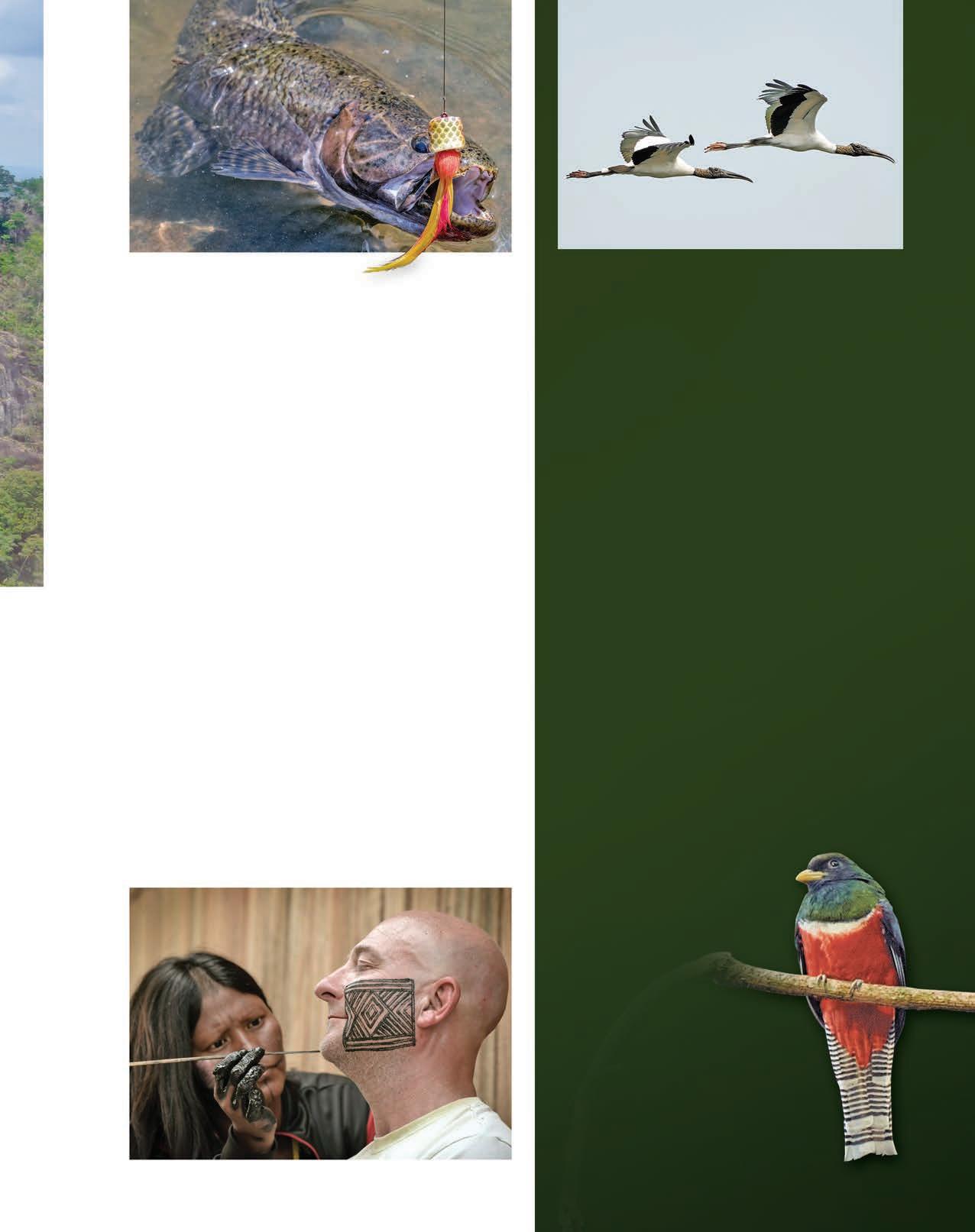
Waterproof journal & pen
Camera & telephoto len(s)

THEXINGURIVER lies deep in the heart of the Amazon. It flows swiftly over granite bedrock and runs clear from its headwaters to its confluence with the Iriri, over 300 miles downstream, all of it inside the protective borders of the Kayapó’s Indigenous Nation, inside Brazil. It is a broad but braided river made up of riffles, pools, oxbows, channels, lakes, lagoons, rapids, drops and waterfalls that create the finest payara habitat in the Amazon basin.
The impressive and ferocious-looking payara, aka the “Vampire Fish”, are nicknamed for the two enormous fangs protruding from their bottom jaw and penetrating through their forehead. There may not be a more savage-looking game fish swimming in freshwater. If you want to pick a fight with one, there is really no place else to consider. Nothing else compares.
While the payara are considered the primary angling target at Xingu, fly fishermen will enjoy the pursuit of a plethora of other superb gamefish in this clearwater fishery. Big wolf fish can be targeted in the shallow lagoons and pocket water, several different ultra-colorful varieties of peacock bass are caught routinely, as well as big bicuda, pacu and more! This is truly an exotic jungle fly fishing odyssey in the midst of authentic Amazonian culture!
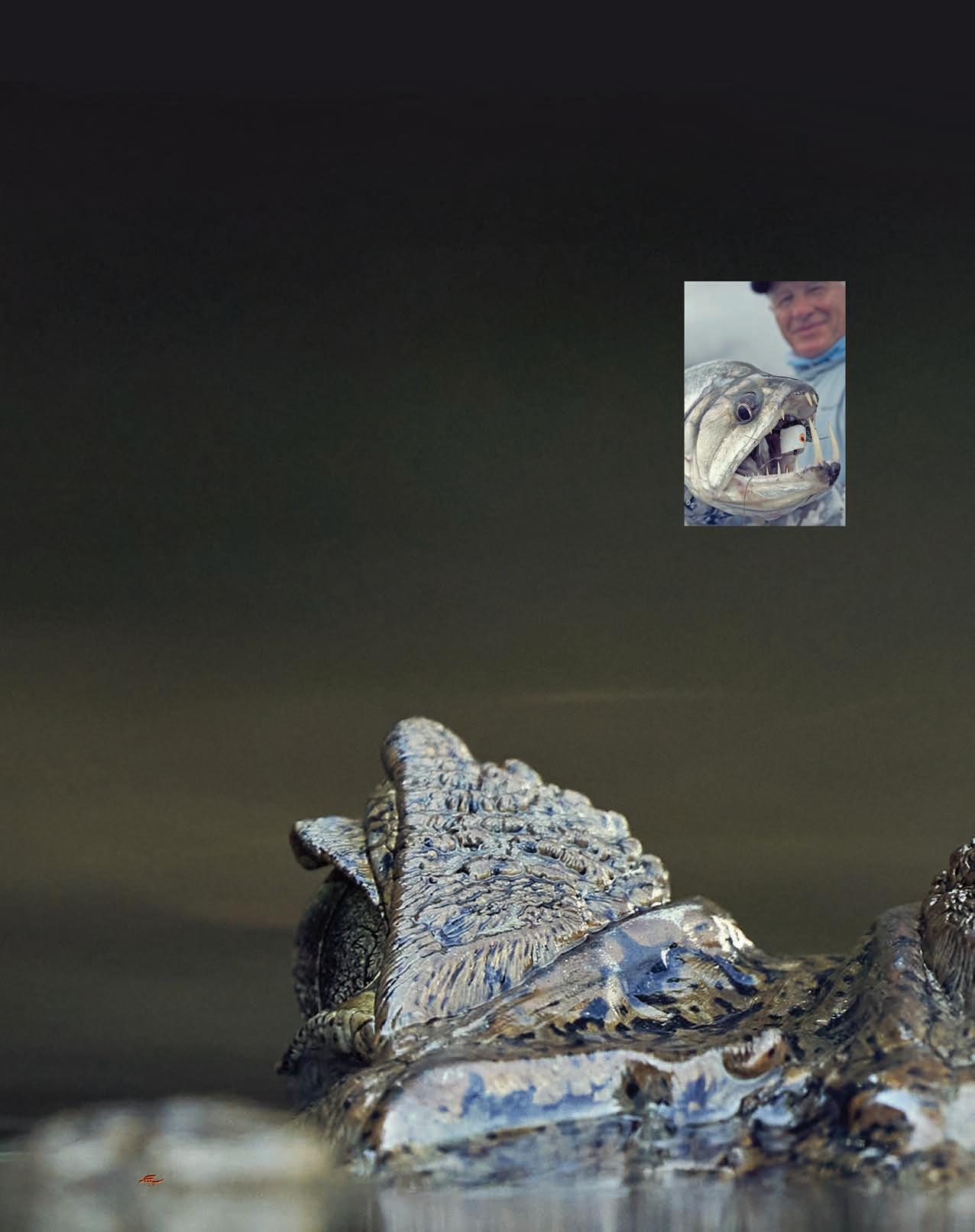
FEWOTHERSPORT fishermen, and no commercial fishermen have ever been allowed on the Xingu. In fact, few non-natives have been tolerated in the massive Kayapó Indigenous Territory at all. The natives harvest only what they can immediately consume from the fish-rich river and do not focus on payara, pacu, or peacock bass as part of their diet. These fish are both plentiful and aggressive, and it is doubtful that they’ve ever seen a fly. Just imagine.
The Xingu experience is a great deal more than just another wonderful fishing trip. The Kayapó natives are famous for their efforts to preserve their culture and have resisted the introduction of modern technology beyond what they collectively feel is necessary for their health, and what is needed to assist them in the protection of their community and traditional way of life. Many are simultaneously computer literate and cell phone savvy, yet don’t own a pair of shoes.
The ultra-comfortable Xingu Lodge is the first non-native, modern structure allowed near their native village. The lodge features comfortable double rooms with full bathrooms, hot water, electricity and satellite wifi internet. The camp is located on the bank of the Xingu River, overlooking a gorgeous rapid and home pool.
Anglers at Xingu will have the opportunity to meet the tribe, and to participate in their ritual body painting and tribal ceremonies. Most of the very few visitors to both Xingu and Kendjam return home with a complicated mix of both exceptional angling and cultural memories.
vampire fishing on the xingu
The Fly Shop® has thoroughly vetted this thrilling, exotic, action-packed trip. The journey to Xingu begins with an overnight in Manaus, adding just a day to the trip. All airport and ground transfers, superb hotel accommodations on the night of arrival, and the 3-hour charter flight to the Kayapó village airstrip in the jungle are included in the package price. Upon arrival at the Xingu Lodge your eight person group will enjoy comfortable shared accommodations, superb meals, excellent guides, daily laundry, en suite bathrooms, hot showers, and nightly generated power.
s 8 night/6 day fishing package $6,944

The short season begins in August and ends in mid November
Not included is a $567
Native Community fee
THEFIRSTGROUPS of anglers allowed to trespass into the heavily guarded, government protected Xingu portion of the Kayapó Indigenous Territory arrived in September of 2019, accompanied by fisheries biologists and escorted by the Brazilian version of our own Bureau of Indian Affairs. It was an experiment sanctioned with the support of the native community and only after the cultural and financial success of Untamed Angling’s Kendjam Project.
The size and numbers of payara they encountered, along with the variety of gamefish species left absolutely no room for exaggeration.
However, no further visitors were permitted after that first visit (and the following onset of the viral pandemic) until the entire adult native population was vaccinated. We could not be more excited to be invited back! Our first returning guests picked up right where we left off in 2019, rediscovering the best payara fishing on earth.
THISLUXURIOUS floating lodge was founded by a group of hard-core Brazilian anglers who joined forces six years ago to provide like-minded, adventure-seeking anglers with a quality operation in a well-managed fishery. Their deluxe operation provides an extremely modern, ultra comfortable, and ecologically-minded approach to sportfishing in the Amazon jungle. The entire lodge was built of renewable hardwoods, with 16 spacious guest rooms, each with a private bath and riverfront patio.The entire facility including the dining room, bar, lounge and guest rooms is comfortably air conditioned. The outdoor tackle room was built by fishermen, for fishermen, with a huge rigging table and rod racks overlooking the river and with spectacular views of the surrounding jungle.
Don’t let the luxury fool you. This is a terrific fishing lodge. It’s an easy boat ride to sandbar flats and sight-fishing for peacock bass, or rapids sheltering huge payara, and the medley of other angling options in the vicinity is staggering.
Anglers fish the Juruena, Teles Pires, and Tapajós Rivers and their tributaries, the Bararati and Aximari Rivers. In addition to these majestic Amazon basin rivers, guests have access to dozens of pristine lakes and lagoons in a jungle filled with some of the most exotic birds in the world.

These waters are home to more than 20 species of tropical game fish, including piranha, jatuarana, brycon, bicuda, wolf fish, payara, arowana, jacundá, tambaqui, and an astounding population of two species of peacock bass.
Scarlet Macaws fly through the jungle canopy while you fish with your indigenous native guide, cayman float in the quiet waters, and jaguars prowl in the heart of darkness.
Few destinations in the Amazon include all of the nearby fly fishing options or the exquisite level of accommodations and service found at Eco-Fishing Lodge. Amenities include daily laundry service, reliable hot water in high-pressure showers, televisions with all major American channels, satellite telephone for emergencies, and both WiFi and internet access.
Eco-Fishing Lodge gets The Fly Shop’s enthusiastic thumbs up and we highly recommend it for the angler searching for 5-star comfort and fishing variety.

This prolific jungle fishery includes a daily angling menu with as much variety as any other spot we’ve ever seen!
eco-fishing lodge
The 2024 package includes an overnight in Manaus on arrival, charter flight to the lodge, all meals, soft drinks, beer, cocktails, guide service, fishing license, laundry service, and single, private accommodations (with two anglers sharing a boat and native guide ). s 8 night/6 day fly fishing packages $6,720 per person
Local rivers clear quickly when the rains end in June and sight fishing is great during the July thru September peak season.
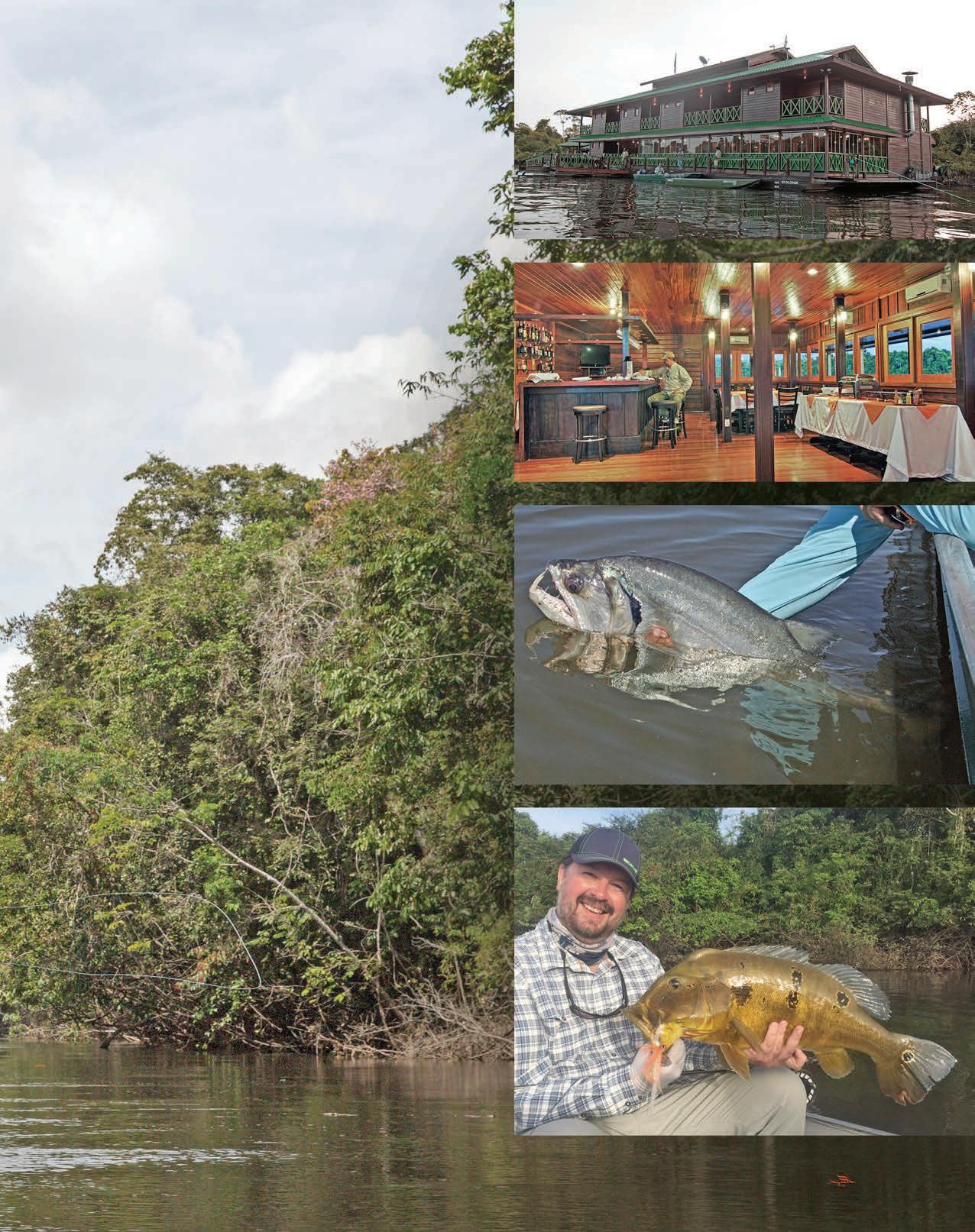
Huge, prehistoric, acrobatic payara and many other exotic quarries share the river with a staggering population of peacock bass.
One of the only two angling destinations in Brazil dedicated to fly fishing only, this superb facility was selected by Forbes Magazine as one of the top ten fishing lodges in the world!
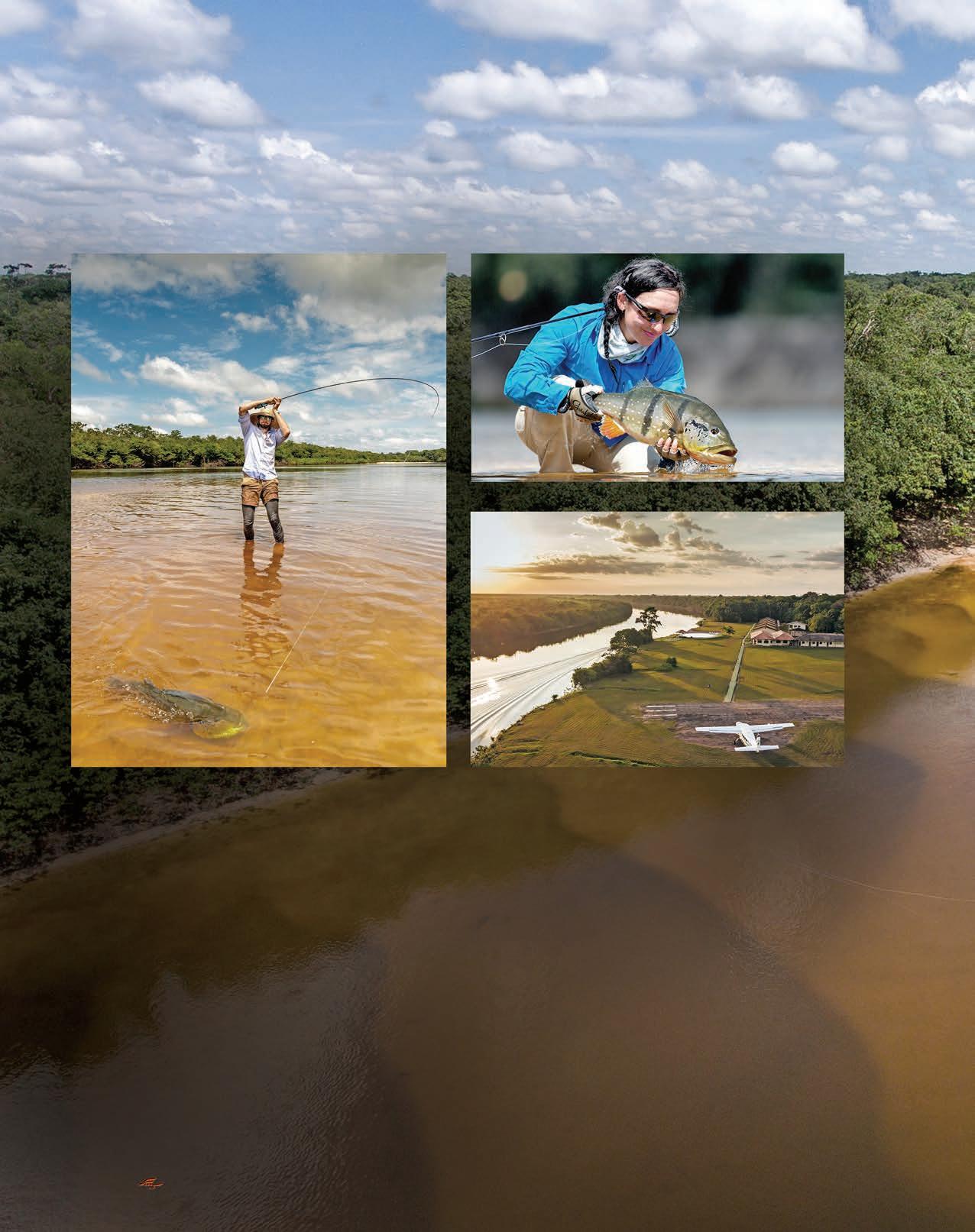
AGUA BOA LODGE guest accommodations are second to none in Brazil, and its swimming pool is a welcome sight at the end of a tropical, fish-weary afternoon. The well-trained, English-speaking, native guides are dedicated fly fishermen and the fishing is terrific.
There are remarkable numbers of peacock bass, including significant numbers of the monster temensis variety and a nearendless supply of the smaller “butterfly” (borboleta in Portuguese) peacocks. The river's white sand bottom and clarity makes Agua Boa particularly well-suited to sight-casting, setting it apart from many other peacock destinations.
Agua Boa is operated by one of the most respected outfitters in the business and is first-rate in every category. It accommodates eight guests, is strictly fly fishing only, and has exclusive access to over 100 miles of the Agua Boa River and its lagoons. Because the Agua Boa is an ecotourism preserve, only one licensed sport-fishing operator is allowed on the entire watershed. Absolutely no commercial fishing has been allowed for decades and the sportfishing is beyond remarkable!
The peacock bass action is near non-stop in January, February, and March and fish in the doubledigit category are common. Biologists estimate that the Agua Boa is one of the top three trophy peacock bass rivers in the entire Amazon.
Naturalists will appreciate that the Agua Boa River is bordered by a primal hardwood forest reaching hundreds of feet to the sky and is home to world-class birdwatching and wildlife viewing.
The lodge offers a level of comfort unrivaled in the Amazon. Guests stay in private, air-conditioned bungalows with two queen beds, a sitting area, private bath, and a porch overlooking the river. The lodge has every amenity imaginable including a phone line, satellite TV, WiFi, well-furnished library, 24-hour electricity, game room, swimming pool, full bar, a wonderful indoor and outdoor dining room, fine meals, cold drinks and a top-notch facility.
This is a perfect spot for the expert and novice angler, and the discriminating traveler.
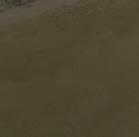
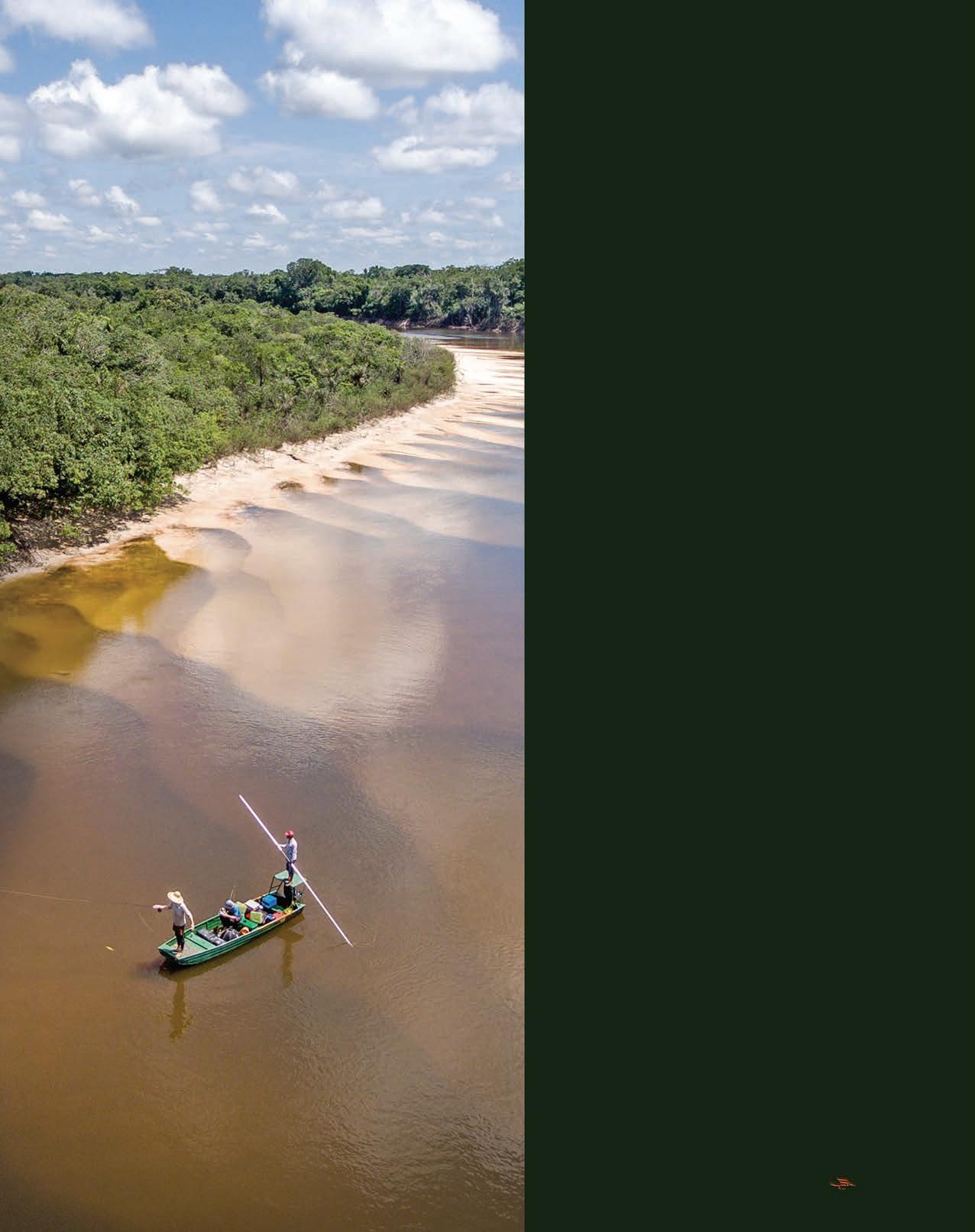
Sight fishing in gin-clear water for peacock bass
The waters of Agua Boa, under normal conditions, are crystal clear and offer sight-casting to cruising peacock bass as well as the elusive Arowana as they glide across sandy-bottomed shallows. Its waters flow out of the “mountains” of northern Brazil, and during the dry season, the river runs low and clear. Once you have fished the crystal clear-waters of the Agua Boa, you will come to realize why this river is so unique and special. If you like to hunt your fish and sight-cast in clear water for some of the strongest freshwater fish species in the world, then Agua Boa is right for you.
Variety of different types of water keeps it interesting
The fishing program at Agua Boa is not just confined to the actual rivers. Much of the fishing takes place in the many lagoons and small creeks leading off from the main river channel and also in hidden lakes and oxbows deep in the rainforest, waters left behind after the rainy season floods. This allows anglers the ability to fish different types of water, and no matter what the weather and water conditions your guide will be able to put you on fish – now that’s peace of mind.
Fly fishing only/Catch & Release fishery
Agua Boa is exclusively a fly fishing destination, with a strict “catch and release” policy, single barbless hooks only. Fishermen at the lodge have taken at least eighteen different species of fish on a fly in the waters of the Agua Boa. A strict fly fishing only, catch a release policy ensures a healthy fishery with excellent populations of a variety of different fish species; this makes this destination fishery a favorite for fly anglers looking for multiple fish species and a high quality fishing experience.
Your own private nature reserve
Agua Boa Amazon Lodge is a Nature Reserve, located between an ecological park and a national park. The Agua Boa River and its surroundings have an Ecotourism Reserve Status and consists of thick rainforest and savannah and are home to the Jaguar, Tapir, Sloth, freshwater ( pink ) dolphin, giant Amazon Otter, Capybara and a myriad of other animals, many of which are endangered. The birdlife is tremendous, a veritable paradise for birders, and provides fantastic photographic opportunities. In any typical square mile botanists have discovered an incredible 3,000 different plant species, 1,500 flowers, 750 species of trees, 400 different bird types, somewhere in the neighborhood of 150 different species of butterflies and moths, and approximately 160 kinds of reptiles and amphibians. There is something for everyone at Agua Boa, anglers and non-anglers alike – everyone will be happy!
World class lodge complex
Agua Boa Lodge is a deluxe facility and the perfect jungle retreat for anglers and non-anglers. The lodge features 24-hour electricity, air conditioning, reliable internet, satellite television, snooker, ping pong, and an extensive library. Guests stay in well-furnished, air-conditioned bungalows, each with a large front and back porch with hammock and sitting area. Every room features two double beds, a reading area, frig-obar, and table. The bungalows have hot and cold running water, flushing toilets, and enough storage for even the best-packed angler. Outside there is a 20-meter swimming pool, bar area and easily accessed hiking trails where knowledgeable guides will provide explanations of the flora and fauna. Meals are delicious, prepared by professional chefs, and the three-course dinners with wine are served in the dining room each evening. Just because you are in the middle of remote Amazonia doesn’t mean you need to be uncomfortable – Agua Boa is a deluxe destination lodge, perfect for the most demanding guests.
FORGETABOUT drug cartels and guerilla warfare, visiting Colombia is now a wade in the South American park since its government has settled political unrest problems and driven the drug lords from the once-famous sportfishing rivers in Latin America.
Mike Michalak, Terry Jepsen, Eric Ersch and Mike Mercer (all from The Fly Shop®) extensively fished and explored the waters of Colombia’s Mataveni River some years ago, returning with rave reviews and reports that would be difficult to swallow if they’d come out of someone else’s mouth.
This legendary river was once home to virtually every world record peacock bass. At one time six of the top ten IGFA all-tackle, and many of the fly caught peacock bass world records came from this jungle hotspot. Then, 40 years ago, the region became a “No Go” zone when guerilla insurgents arrived, and anglers understandably lost interest in the Mataveni.

The bad guys (FARC - Revolutionary Armed Forces of Colombia) have now been pacified and enthusiasm among anglers is quickly returning for the Mataveni and several other terrific regional rivers. The two Mataveni native villages near the Orinoco confluence are the only inhabitants on the entire 400 mile-long river.
With the help of the government and with military support this small band of natives completely restricts and controls access.
Eager to be among the first to size up the river, Michalak accompanied the first two groups of North Americans allowed to fish this legendary peacock bass river in four decades. The peacock bass of the Mataveni held a welcome-back reception for the gringos, the weather cooperated perfectly, and the fishing was off the charts.
This program is outfitted and hosted by Cristian Vanegas, a wellknown Colombian fly fisherman and outfitter, owner of Pesca Colombia. Groups of no more than ten fly fishermen overnight in the capital city of Bogotá at a fine, near-airport hotel before continuing on to the pueblo of Puerto Inírida where you will overnight at a simple hotel. The next morning it’s a swift and quick boat ride down the Orinoco River to the mouth of the Mataveni where you will rendezvous with the fish-savvy team of native Piaroa guides and motor upstream to camp.
These single occupancy tent camps are no-frills affairs, perfect for those of us who need no more luxury than a cold beer at the end of the day or ice for our cocktails. And more appropriate for those of us who care more for great fishing than lodging. In fact, everyone in our groups found the comfortable, spartan camp atmosphere refreshing.
The first angling day a diminutive Piaroa guide lifted one more of a series of Temensis monsters out of the tea-colored river for a photo and said in his Indian-accented Spanish, “You’ve got to come back when the fishing is good!”

The native villagers strictly limit the number of weeks they allow the river to be fished each season (two weeks a month), resting the river and themselves every other week each month. And only a few intrepid Colombian nationals have been going there regularly during the years in which it was impossible for most foreigners to arrange fishing there.
The 2024 camp packages include hotel accommodations in Bogotá on the night of arrival and departure, lodging in Puerto Inírida, all meet and greet services, all transfers, and round-trip Puerto Inírida flights. Sodas, bottled water, Gatorade, and nearly everything but your tackle and tip.
s 10 night/6 day fishing package $4,800 + $600 Indigenous fee
The short season begins in January and ends in April
JOINMEMBERS of The Fly Shop’s Travel Team for a return trip to the Mataveni in 2024. We picked an absolutely deadcenter fishing week in one of the premier peacock bass fisheries on earth (limited to 10 anglers only).
The Fly Shop’s 2024 Hosted Trip Itinerary
Host: Terry Jepson terry@theflyshop.com
Thursday - March 14, 2024
Scan this code for more info on Terry’s hosed trip to the Mataveni
Arrive in Bogotá, Colombia, where you will be met by Colombia Pesca and transferred to the Black Tower Hotel.

Friday - March 15
Morning transfer from the Black Tower Hotel to the airport for your one-hour flight to Puerto Inirida. Hotel accommodations in Puerto Inirida - Hotel Las Vegas.
Saturday - March 16
Travel by fast boat from Puerto Inirida to the boca of the Rio Mataveni and the Rio Orinoco, followed by a 3.5-hour transfer to the Mataveni Camp.
March 17 - 22
Six full days of guided fishing
Saturday - March 23
Depart Mataveni Camp for Puerto Inirida and overnight at Hotel Las Vegas.
Sunday - March 24
One-hour flight from Puerto Inirida to Bogotá. You have the option of departing on a flight back home this evening after 7:00 PM, or if you prefer overnighting at the Black Tower Hotel (included in package) and departing the following morning – all transfers included.
THEMODERNCAPITALCITY of Colombia, Bogotá is a bustling city with just over 8 million inhabitants, the third largest city in South America after São Paulo, Brazil, and Lima, Peru. Sitting on a high plateau at 8,660 feet above sea level, Bogotá is the third-highest capital city in South America after Quito and La Paz. It’s a city rich in 15th century Spanish culture and architecture with a tremendously developed infrastructure including a modern airport, public transportation, international hotels, boutique shopping, green parks and museums, along with fine restaurants and bars. We highly recommend that anglers consider spending a couple of extra nights in Bogotá on the front or back end of their trip to fully appreciate this thriving metropolis and soak up some of its culture.
INÍRIDA IS A PORTCITY located in the province of Guainía which in the indigenous Yuri language translates to “land of many waters”. The city sits at the confluence of the Inírida River and Guaviare River, 19 miles from the Venezuela border and the Rio Orinoco. These 3 rivers combined have been named the “Fluvial Star of the South.”
This sleepy little community is growing quickly and mostly populated with natives. The area has benefited from major security gains since the 2016 peace accord with the Revolutionary Armed Forces of Colombia ( FARC ). Three-wheeled auto rickshaws fill the streets and will whisk you to the many cafes and cantinas that fill this port town. Tourist attractions include the hieroglyphs in Inírida and the “Crying Rocks of Mavecure.” Inírida is a fascinating glimpse into rural Colombia with a friendly native atmosphere and days worth of activities.
We are going back to the Mataveni and couldn’t be more thrilled

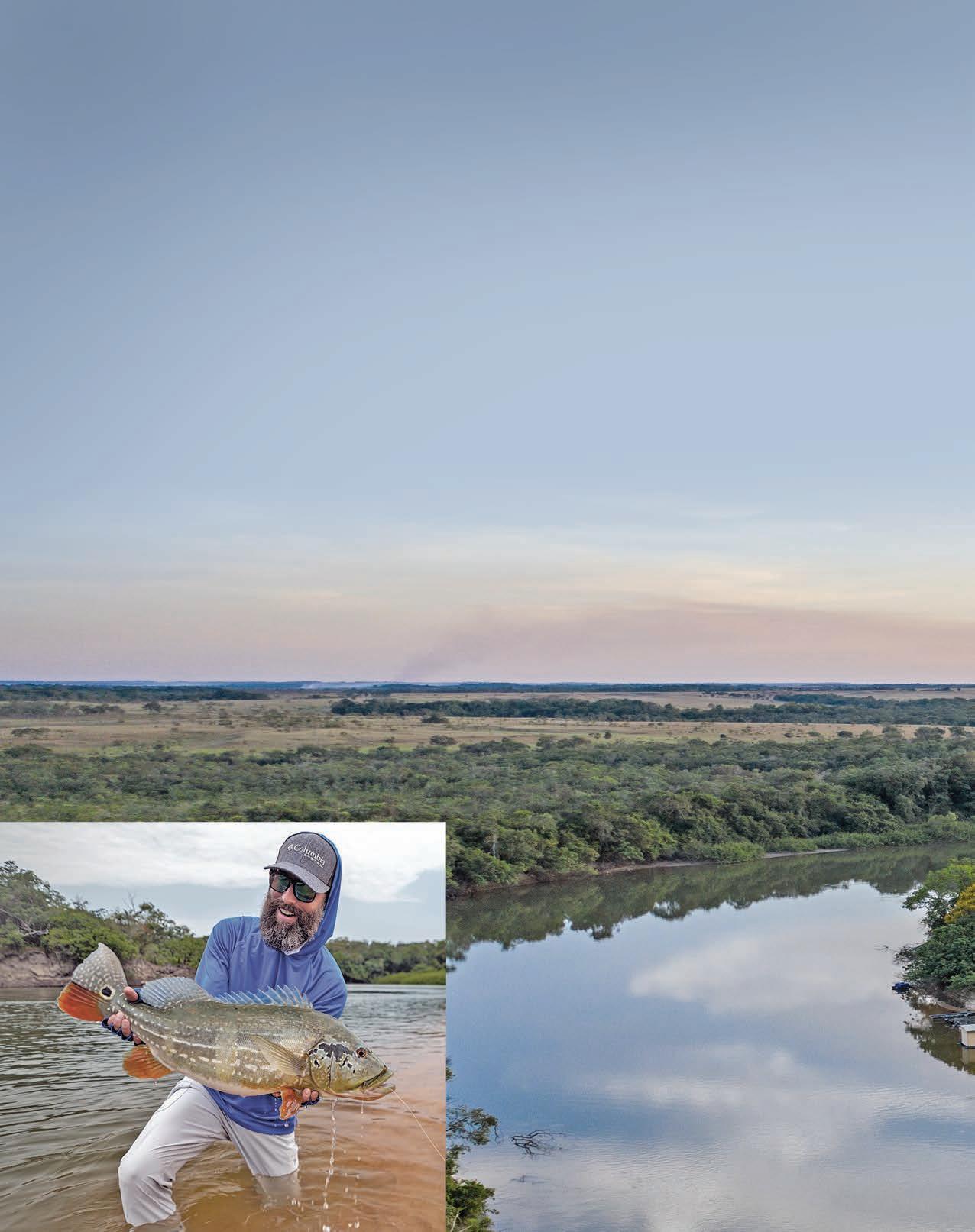
Temensis - Cichla temensis
Butterflies - Cichla orinocensis
Royal or Intermedia Peacock Bass - Cichla intermedia
THE TOMO is a diverse fishery with daily shots at large Temensis peacock bass that can hit the 20-pound mark and above. In addition to trophy-sized peacocks, the rivers and their endless back bays and lagoons have a very strong population of two other species of fierce, hard-hitting and fighting peacocks for anglers that predicate their success on big numbers of daily landed fish. It’s an action-packed and exotic jungle angling adventure in a remote setting, just what we like in a jungle fishery.
This experience is an opportunity to live and fish in a true jungle wilderness. Your camp will be located on a long white sandbar in a jungle, with the sounds of parrots filtering down through the trees at dawn. For a week your small group of anglers will have this world-class fishery all to yourselves, guided by locals. It’s not uncommon to observe howler monkeys, capybaras, tapirs, and if you are lucky an anaconda or jaguar. You can fish popping bugs for butterfly peacocks, cast to schools of baitfish being destroyed by hungry giant peacocks, and then dine on a delicious meal for dinner. We guarantee that you will never forget your journey to fish the Tomo River, and the wilderness that surrounds it.
Your trip to the Tomo River is well-designed and orchestrated, beginning with an overnight stay in the fascinating city of Medellín. Medellín is the capital of the Antioquia Province, a fertile region famous for its coffee plantations and flower farms, orchids and butterflies, and is known as the City of Eternal Spring for its idyllic climate. The next morning, from Medellín you will fly in a private charter to La Primavera, Vichada, followed by a fourhour drive in air-conditioned 4-wheel-drive trucks to the river –yeah, it’s really remote! The trucks are well-stocked with water, soft drinks, beer and a full lunch for the drive. Upon arrival at the river your guides will be waiting with skiffs for the final water transfer to the floating camp.
Perfectly paired with hunting big peacocks are targeting the large numbers of butterfly and Royal peacocks. These fish like to gather in schools and are ferocious feeders and very aggressive. Anglers can expect to catch these two species in high numbers both with subsurface and surface flies aggressively fished over shallow water shoals, sand flats and lagunas.
Each morning pairs of anglers, accompanied by a seasoned guide, depart the front deck of their floating cabins in skiffs and travel varying distances to the fishing grounds. Some days the fishing is within close proximity of the lodge, while on other days you may travel a substantial distance to explore remote locations. The boat rides are an exciting part of this jungle adventure and highlighted by sightings of a variety of wildlife.
The fishing program incorporates two distinct fisheries – the Tomo River and its tributary the Gavilan. The Tomo is a large river, with miles of varied water to fish and explore, including cutbanks, underwater structure, sand flats and shoals as well as oxbow lagoons. Some of these lagoons and oxbow lakes are accessed by a short hike along a well-established trail to a hidden lodge skiff.
Downstream of the camp is where the Gavilan tributary joins the Tomo, and skiffs will turn upstream to explore and fish its clear waters. This is where the majority of sight-fishing takes place and is not to be missed.

The Akuani Float Camp, outfitted by Afloat, is a first-rate peacock bass fishery allowing anglers a terrific cross-section of high volume fishing along with a daily chance of landing a true monster fish of 15 pounds or larger. What it may lack in creature comforts compared to a land-based operation is more than made up for in its ability to stay within easy and short striking distance of high-quality fishing. The floating lodge allows the outfitter the ability to manage the water for optimum fishing by rotating beats over a 75mile stretch of river.
The remote floating camp features five double occupancy cabins, and although the cabins are certainly comfortable, well-equipped and efficient given the operating environment, they are not deluxe. Each cabin accommodates two guests and are not air-conditioned, but do have individual oscillating fans over each bed that run during the night. The cabin’s open-air design allows for plenty of air circulation. A flush toilet, as well as a coldwater shower, sink and vanity to round out the cabins.
The angling window is short, coinciding with the dry season and low water flows – December through early April.
The 2024 camp packages include hotel accommodations in Medellín on the night of arrival and departure, all meet and greet services, all transfers, and round-trip private charter flights to La Primavera, Vichada. Sodas, beers, bottled water, fully-equipped room in floating camp, two single beds, electricity, bathroom, fans, and nearly everything but your tackle and tip. s $4,500 USD + $400 (Native Community Fee )
This high-quality adventure is a terrific value in the world of peacock bass fishing.
YOU MAY HAVE heard of a recent proposal (Decision C-148) to ban “catch & release sportfishing” in Colombia – really! However, nothing has been put into law, it is only a proposal, and the Constitutional Court of Colombia still needs to debate and modify the bill before finalizing. According to our Colombian outfitters, that will take several years and the bill will certainly be retooled to allow catch and release sport fishing, as the cultural preservation, social interaction with indigenous tribes, environmental protection, and support of Colombia’s tourism economy are significant.
Visibly, in an example of convergent evolution, these fish are shaped like king salmon…but with terrible orthodonture and an even worse attitude. If one were to be tied tail-to-tail with most other freshwater species, it would pull the scales off its opponent, then probably turn around and eat it.
GOLDENDORADOARE so aggressive that they eat each other, they eat their young, and in the juvenile stage they swim in small circles chewing at each other’s tails. In fact, it’s rare to find a small, young dorado without visible wounds, and that hasn’t been physically and emotionally scarred by a relative. They’re the ultimate dysfunctional family in the fish world, and display only two modes of behavior: Kill and reproduce. Apparently they can multi-task and are often in both modes simultaneously.
By nature, dorado are mean as hell. They show no mercy, and often chase their prey into inches of water.

The violent pursuit of these baitfish telegraphs the location of the dorado, and a quick, well-placed streamer will usually connect. These fierce, ill-tempered fish will take flies both sub-surface and on top of the water. Techniques are simple, and the whereabouts of dorado is predictable. They have no predators, often lie in plain sight, and stalking them from the shore is thrilling.
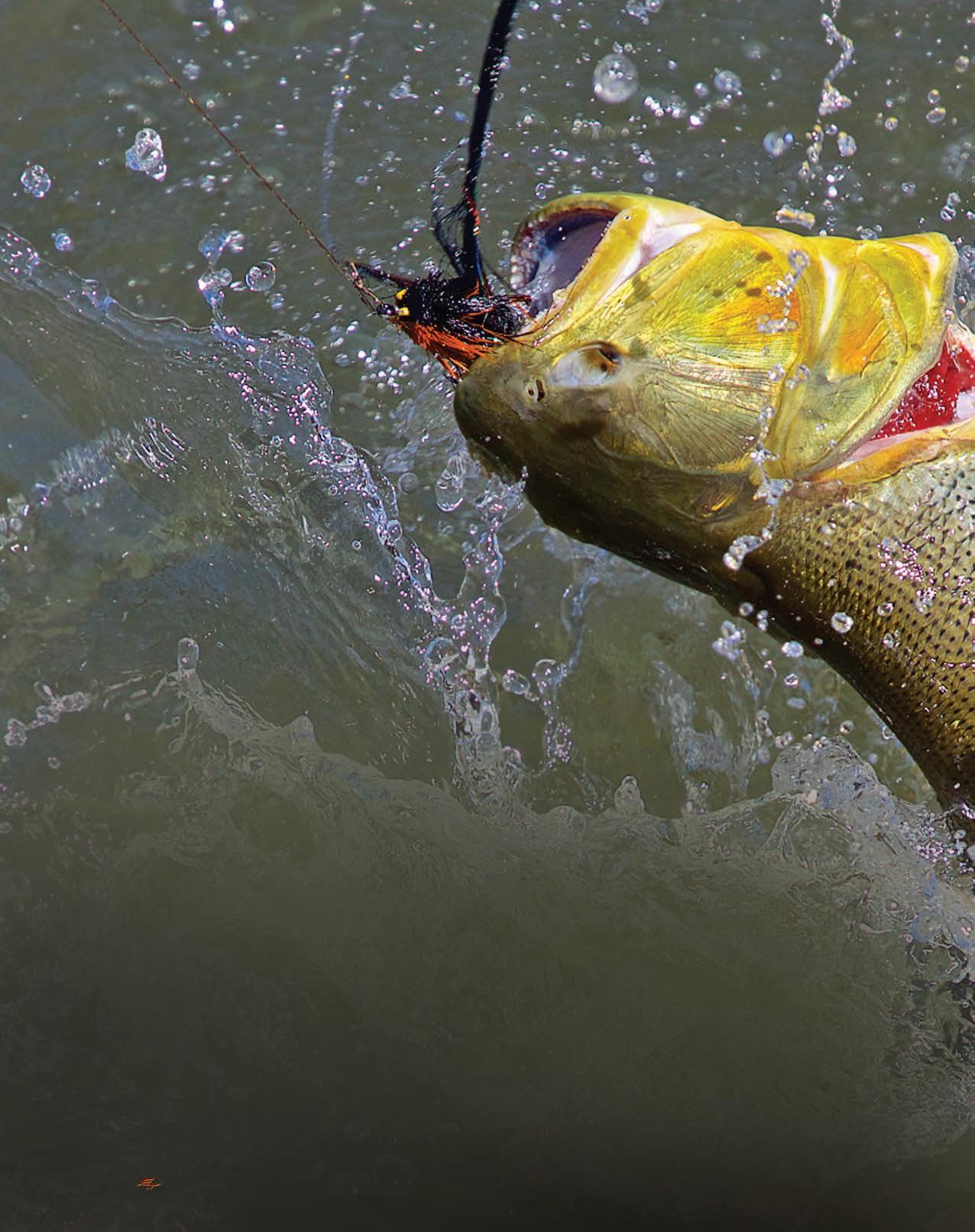
The strike of a mature dorado can be either subtle or violent, but when the fish feels the steel, all hell breaks loose. Dorado are ferocious animals that don’t give up easily. They’ll usually go airborne immediately, and the battle is charged with explosive bursts of power punctuated by tailwalking attempts to toss the hook. When the struggle appears over and they’re being landed or photographed, they’ll often attack the angler!
Here at The Fly Shop® we’ve become addicted to dorado fishing. The places we find them are, at the same time, exotic and fantastic. The native range of golden dorado is southern Brazil, Bolivia, Uruguay, Paraguay & Argentina
WE DON ’ T KNOW of a more badass freshwater gamefish than the golden dorado. Dorado are meaner than a junkyard dog and landing a big one is a feat in itself…If you aren’t paying attention and turn your back on one for a second while posing for a grip-n-grin, they’ll try and take a chunk of flesh out of you.
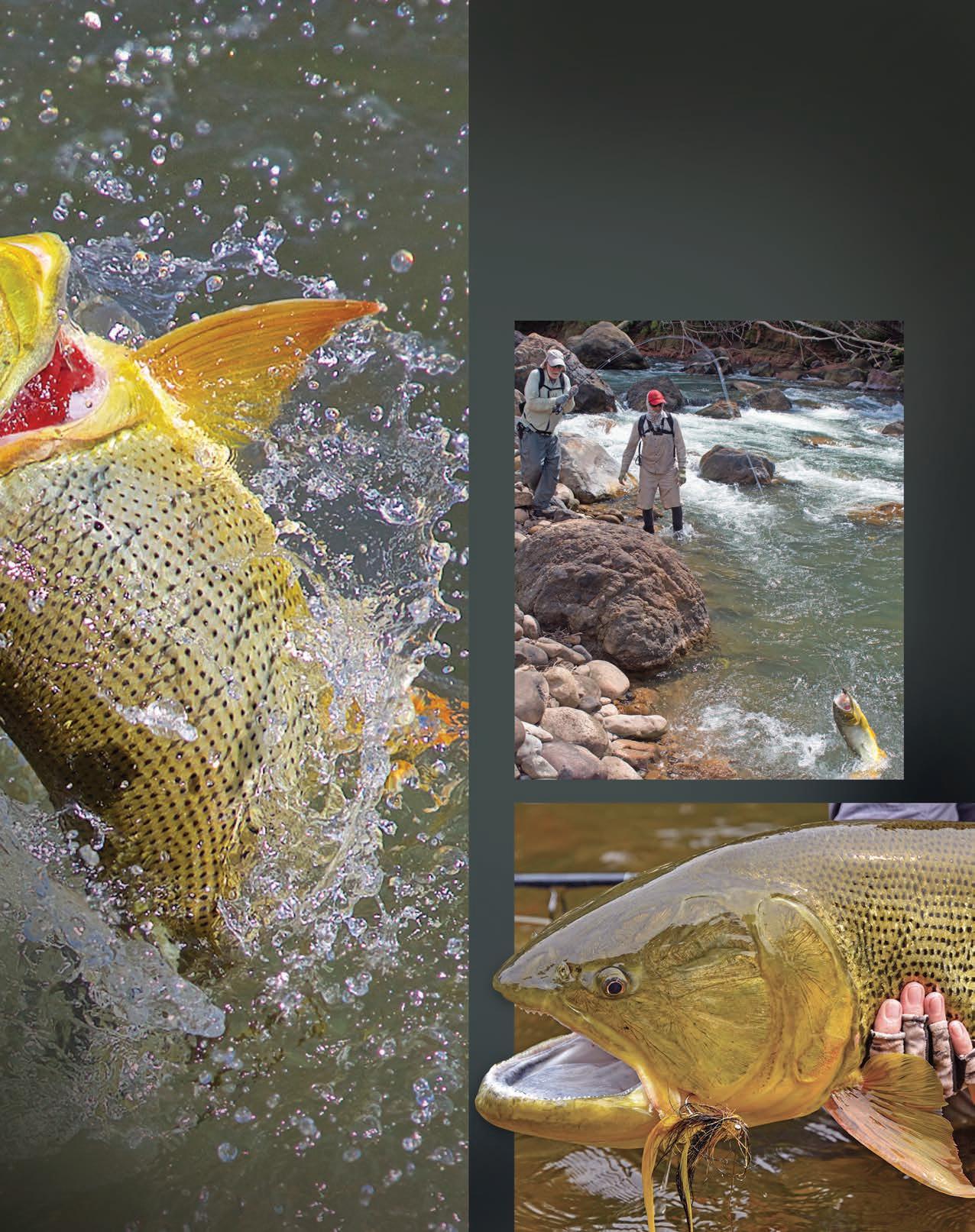
They are belligerent and nasty — everything we like in a fish that attacks 8-inch streamers as they actively prey on mega-sized baitfish…and each other.
In our book, this badass carnivore may be the ultimate freshwater gamefish!
Tsimane is in the heart of Bolivia’s Indigenous Territory. It’s a wild country where the Amazon jungle meets the Andes and is definitely in the conversation for the most unique and exciting freshwater destinations that have entered the world of international fly fishing in a generation.
TSIMANE IS a remarkably different jungle experience, sightcasting to monster dorado that can tip the scales at up to 40 pounds, in gin-clear, freestone rivers, with fierce pacú up to 25 pounds cohabitating with them. Much of the fly fishing is done in mountain fisheries that are often as clear as any western trout stream. It’s angling in a spectacular tropical jungle setting accented by exotic birdlife and a list of other unique animals, and set to a cacophony of jungle noise.
We hunt golden dorado with light tackle, and spot them in shallow water, busting bait, or lying in structure ready to ambush anything in range.

The pursuit is often done on foot, with pairs of anglers wading or stalking foraging fish from the banks of these freestone rivers. When individual dorado are spotted, fishermen usually alternate shots. The wading and the walking aren’t tough, but there’s a lot of it. The angling days are often strenuous and are best suited for physically fit anglers with a spirit of adventure and an appetite for exotic fishing that’s beyond conventional.
Sight-casting to these fierce cannibals is a thrilling event that must be experienced to be understood.
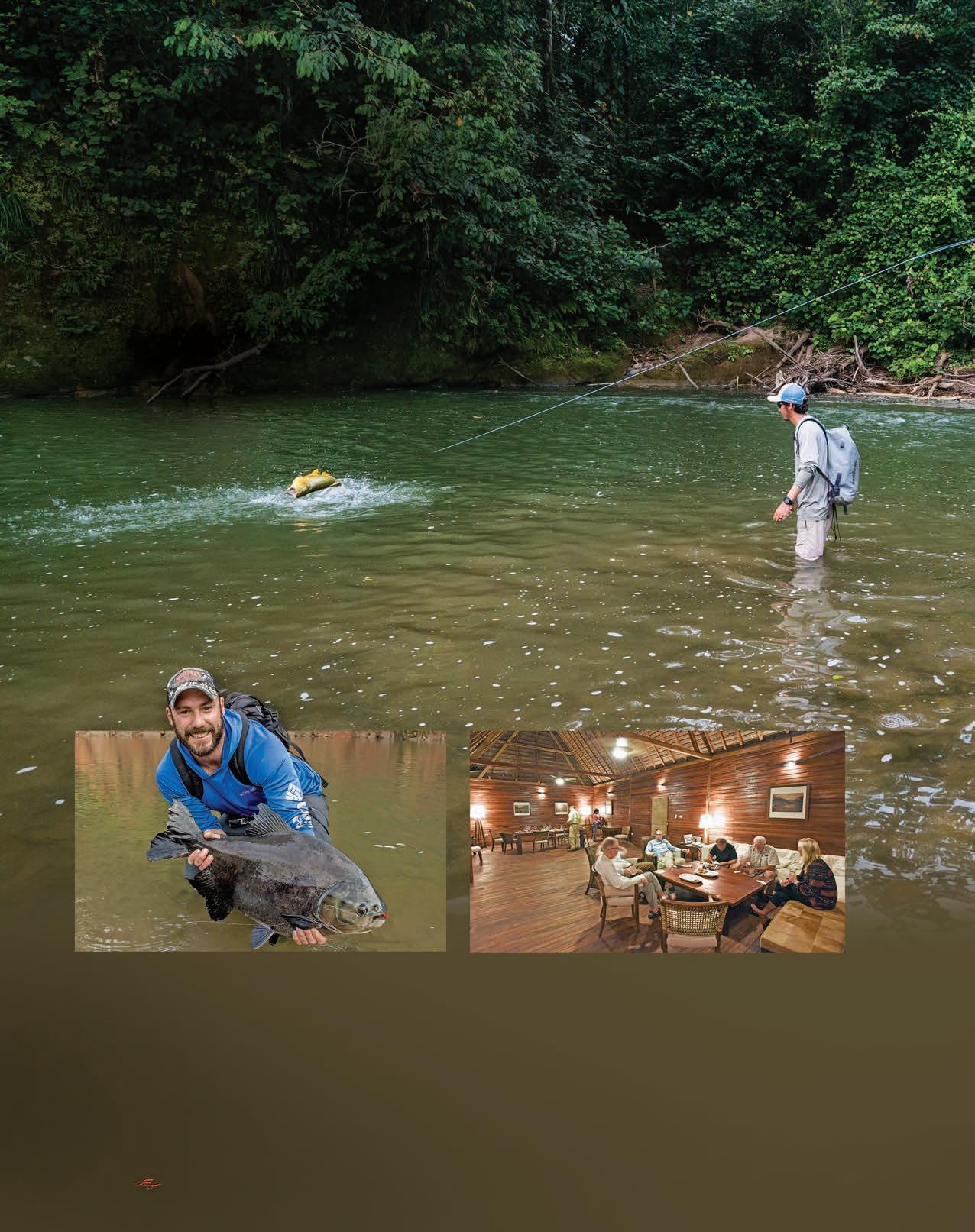
Pluma Lodge is as nice of a place as you will find in the jungle. Carved out of the Amazon forest, it features fine meals and panoramic views of the river, where packs of ravenous dorado hit schools of sabalo at all hours of the day and night. Six anglers have access to fishing that begins at the lodge doorstep, as well as targeting two different, nearby rivers and several smaller tributaries. Adventurous anglers may choose to trek up the rugged Upper Pluma or hike to incredible sight-fishing in the Itirizama headwaters.
Pluma Lodge was sustainably built entirely from material harvested from the local jungle forest and features 6 single/private rooms. Each room is equipped with a private bathroom, spring box bed, hot water, ceiling fans and 24-hour electricity – luxury jungle accommodations by any standard.
Decadent international cuisine, fine wines from Argentina, Chile and Bolivia and an open bar are all included.
s 9 night/6 day package $7,600 per person
Package does not include $670 for indigenous and national park fees.
TSIMANE IS A real partnership between an indigenous native community and private enterprise. The small tribe of Tsimane all participate in the operation of the lodge and camps. These are people who have changed little, other than their clothing, in a thousand years. But, they are invested in their own land and take an ever-increasing role in the management and protection of their own fishery.
Guests at Tsimane will not only enjoy phenomenal fishing, but will be immersed in local culture and surrounded by guides and other natives who contribute a great deal to every aspect of what makes Tsimane more than just another fishing trip.
Untamed Angling photos
ASIFTHETSIMANE experience wasn’t exciting enough, our partners at Untamed Angling have again raised the bar with a helicopter fly out program. Miles and miles of never before fished dorado water, not accessible on foot or from boats, is now reachable by short daily flights in two helicopters from Pluma Lodge. For 2024 anglers will have the option of six full days of helicopter fly-outs or a hybrid fly-out week, featuring 3 flyouts and 3 days of boat/walk and wade fishing. This is fly-out fishing on steroids, the ultimate jungle fly fishing adventure, and we couldn’t be more excited about it. Period.
s 9 nights/6 days fly-out fishing package $16,000

s 9 nights/3 days fly-out & 3 days boat/walk and wade fishing package $12,500
Package does not include $1,250 for indigenous and national park fees.

SÉCURELODGE , like its sister lodges Pluma and Agua Negra, is uber-remote, tucked between two mountain ranges, and strategically positioned to take full advantage of miles and miles of world-class waters home to dorado and pacu. Each morning pairs of anglers, accompanied by an English-speaking pro guide and an indigenous native, set off in specially-designed wooden 28-foot boats powered by small outboard engines or traditional dugout punts polled by natives, to explore both up and downstream of the lodge. The amount of water to fish at Sécure is massive and the dorado are aggressive as hell, and love to pound streamers and poppers. As an added bonus, anglers can opt to venture upriver toward the headwaters, spending a night or two at an out-camp that puts you in some of the wildest country you can possibly fish, anywhere on Earth.
Based on the comforts of the main Sécure Lodge and the opportunity of doing headwaters out-camps, anglers have access to a broad variety of waters and pools which allow groups to fish in new water every day. It is absolutely ideal.
The lodge at Sécure sits on an elevated hardwood deck overlooking the river. New for 2024 the lodge features 6 deluxe, single occupancy, private wood cabins, each with its own bathroom, spring box bed, hot water, ceiling fans and 24-hour electricity. Delectable cuisine, fine International wines and an open bar are all included.

sécure lodge is located in Isiboro Sécure National Park and Indigenous Territory (TIPNIS), established in 1965. The park is home to indigenous people belonging to the Tsimané, Yuracaré, and Mojeño-Trinitario peoples. Access is by invitation only and strictly controlled.
The Sécure River is born at the confluence of the Nutusama and Cascarrillas streams. Along its first sections this river goes from north to south between the Mosetenes Range and the Eva Eva Mountain Range and it is wedged among peaks that range from 900 to 2,000 meters above sea level.
The upper section of the Sécure River is extremely beautiful with crystal clear water, and allows anglers ample opportunities to sight-fish.
Transportation to the headwaters are in handmade Chiman wood dugout canoes (coambas) powered by push poles or small outboard engines. After a few hours navigating upstream, one can encounter two small tributaries, the Ashahana and the Maniquisito, both offering excellent holding water. On the upper Sécure we find dorado up to 30 pounds, many of them resident fish. There are also a lot of pacú, moturos, surubi and yatorana, which are excellent sport.
The lower section of the Sécure River is shallow and open, with grass banks, long gravel bars interrupted by fallen trees, logs and boulders. As you move downstream its clear waters gradually become colored due to tributaries sweeping sediments from the high plateau – perfect for dorado to ambush baitfish. The beats in this sector are more accessible and the river features are diverse with long runs, “flats”, sandy riverbanks, channels and deep pools. Dorado are the unquestionable kings here, though very large pacu can also be caught in the deep pools, where seeds and fruit pods are brought in by the current.

s 9 night/6 day package $7,600 per person
Package does not include $670 for indigenous and national park fees.

AGUA NEGRALODGE was purposely built to be small and intimate, accommodating a maximum of 5 anglers at one time. This is a perfect, private retreat for small groups of friends, or a family looking for an over-the-top angling experience in the midst of the most exotic landscape imaginable. Deluxe, wood-framed, private cabins, ice-cold drinks, and fine meals await fish-weary fly rodders after each day of fishing. And for those anglers with an ounce of adventure in their souls, and who want to get farther away, the remote headwaters out-camps are a must.
The fishing program at Agua Negra is diverse, featuring three distinctly different fisheries – the Agua Negra, Chimoro Stream, and the middle section of Sécure River.
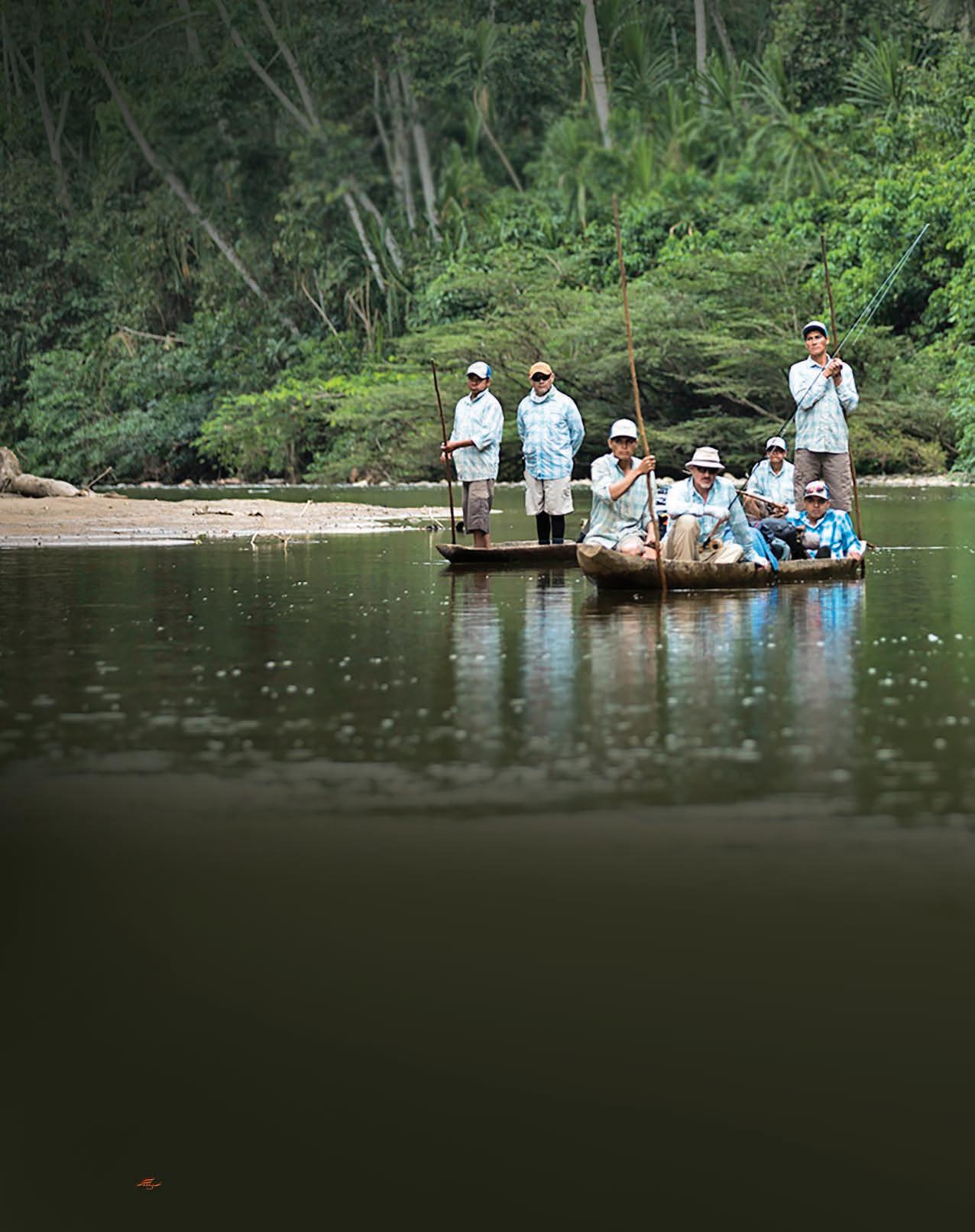
The Agua Negra River is a major tributary of the Sécure and less than half its size. The Agua Negra stacks with migrating dorado from June through the end of September and the clear, shallow waters will remind you of a freestone trout stream back home, except you are in a jungle rainforest! The river is intimate and easily waded, offering terrific opportunities for sight-fishing. As you make your way upstream, the river narrows, increasing in gradient with big boulders, plunge pools and chutes that hold individual dorado looking to attack the migrating sabalo baitfish. It’s up close and personal fishing, unique and extremely exciting as dorado tear through inches of shallow riffles to hammer your streamer and shoot immediately into the air. Good numbers of pacú are also available in this little gem of a fishery.
Chimoro Stream is crystal clear, a small tributary of the Sécure River, and holds good numbers of dorado in the 8 - 15 pound class, with an occasional larger fish as well as good populations of yatorana. Two anglers accompanied by an English-speaking pro guide will motor up the Sécure a short distance to within striking distance of the mouth of the Chimoro. From there it’s all on foot, with you and your guide carefully and patiently dissecting the water looking for a holding dorado. It’s unique, and at times a bit challenging, but the rewards of connecting with a mountain dorado in small water will last a lifetime.
The middle section of Sécure River is a whole different beast when compared to the Agua Negra and Chimoro Creek. The Sécure River is larger, has much more water volume, and holds large dorado. Using 28-foot custom-designed super dugouts powered by an outboard engine, anglers will target large migratory dorado as they make their way upstream following baitfish. These fish are wild and ravenous, fueled by the sabalo they eat, and are tough as hell. The river structure is a combination of logs, sunken trees, boulders, deep cut-banks and long runs. Hooking, then hauling a 20-plus pound dorado out of a sunken tree engulfed in strong current is a real rodeo, and worth the price of admission.
As with the other Tsimane lodges, the Agua Negra out-camps are available to those anglers that want to fully engage the jungle fishing experience. The outcamps are simple affairs carved out of the bush, and offer a unique opportunity to hike to and fish for dorado that have seldom seen a human, let alone a fly. They offer hardcore anglers the opportunity to fish extended hours, beyond the normal guided day.
The lodge at Agua Negra is built from sustainably harvested jungle timber and sits on a high bank overlooking the middle Sécure River. New for 2024, anglers will be accommodated in single occupancy, private, deluxe wooden cabins featuring full linens and bedding, a private bathroom with toilet, shower, and sink. The new cabins are spacious and decorated with handmade hardwood furniture. 24-hour electricity is provided by generators, and renewable energy for charging devices, powering fans and WiFi is available.
Delicious meals are prepared by a chef featuring fresh meats, local fruits and vegetables, and paired with an assortment of wine options. Breakfasts are cooked to order each morning, and lunches are taken riverside. The open bar is always stocked with your favorite libations.
Agua Negra gets high marks from The Fly Shop® for its intimate setting, variety of fishing, and authentic jungle flair.

s 9 night/6 day package $7,600 per person
Package does not include $670 for Indigenous and national park fees.
THEKAYAPÓ people are warriors. They fight to protect what is theirs, defending the jungle that has sustained their way of life for thousands of years. They are unbending against their enemies who try to encroach upon and exploit the natural world that they have coexisted with for millenia. They are an inspiration, a defiant force in the face of a constant barrage of loggers, miners, slash and burn farmers, ranchers, land thieves and mega dams. Against almost impossible odds, they have proved themselves as capable defenders, a symbol of pride and defiance, and the Amazon jungle’s fiercest people.
There was a singular event in 1989 that brought the Kayapó people to the forefront of the world. Industrialists were proposing a mega-dam on Kayapó land, trying to bully them into assimilating, and paying them with empty promises. It was the Kayapó warrior woman, Tuira Kayapó, who sent a clear message. During a protest against the dam, she drew her machete in the face of a government official who was trying to convince indigenous leaders to accept the mega-dam project in the Amazon. Tuira slid the dull side of the machete across his cheek, making it clear that damming the Xingu River would mean a declaration of war against the entire Kayapó Nation.
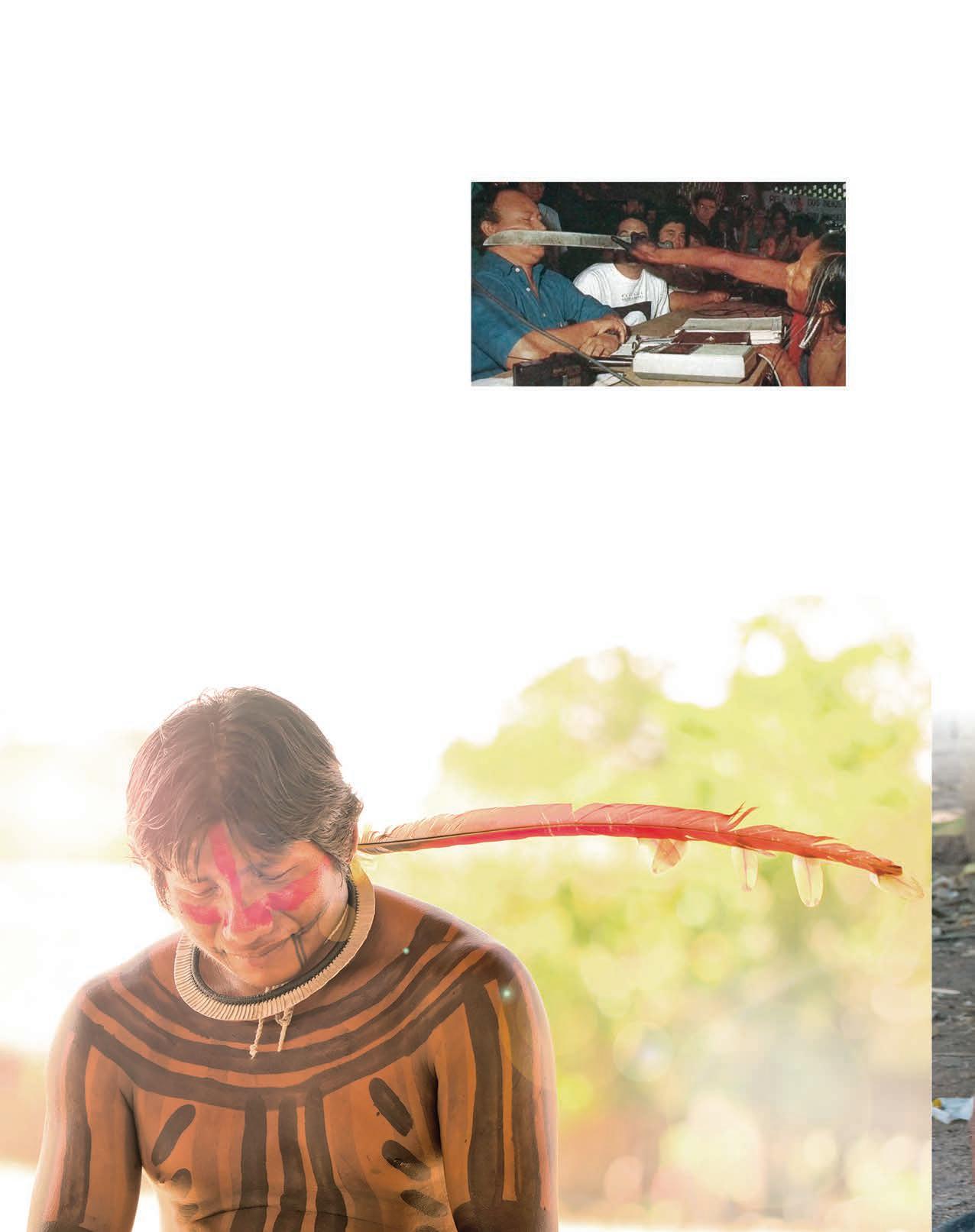
Tuíra, warrior woman of the Kayapó people, confronting a government engineer over the proposed mega-dam project in the Amazon, Altamira, Brazil, 1989.
“You are a liar. We don’t need electricity. Electricity won’t give us food. We need the rivers to flow freely — our future depends on them. We need our forests to hunt and gather in. We do not want your dam. Don't talk to us about relieving our “poverty.” We are not poor. We are the richest people in Brazil. We are not wretched. We are Indians.” - Tuíra Kayapó
DESPITETHEIRFIERCE nature, the Kayapó people have shown a tremendous amount of faith in allowing traveling anglers to visit their lands and fish their waters. Untamed Angling has done a landmark job, cultivating a trusting relationship with the Kayapó tribes of the Xingu and Iriri Rivers with catch and release fly fishing which creates sustainable income and provides jobs for their people; the only project ever proposed to them that did not rely on resource extraction. They demand that their forests and waterways be respected and left in a condition that has sustained them throughout the past, and will into the future, and fly fishermen have proven to do just that.
We hope that the Kayapó way of life never leaves the jungle, and that their children’s children, as well as our own, remember what their ancestors have done and sacrificed to protect what is rightfully theirs. Without the steadfast resolve of the Kayapó people, Amazonia would certainly have a different future.
RAONIMETUKTIRE (born 1932), also known as Chief Raoni, is the most significant Indigenous leader in Brazil. He is internationally famous as a living symbol, fighting for the preservation of the Amazon rainforest, and their indigenous culture and lands.
Kayapó tribes are nomadic, so his childhood was marked by continuous travel, during which he witnessed many tribal wars. Guided by his brother Motibau, at the age of 15 he chose to have a painted wooden lip plate (called a botoque by the warriors of his tribe) placed under his lower lip.
Chief Raoni and the Kayapó nation have fiercely defended the 300 mile long Iri River Valley from loggers, miners and hydroelectric projects. The indigenous communities of Amazonia were instrumental in electing the new president of Brazil Luiz Inácio “Lula” da Silva. So much so that on January 1st 2023, Raoni participated in the inauguration ceremony and climbed the stairs of the presidential palace along with 7 other indigenous chiefs, representing several social and environmental groups, and participated in the delivery of the presidential sash to the newly sworn in Chief of State.
Now, in cooperation with our outfitter Untamed Angling, Raoni and the entire Kayapó nation they have safeguarded their indigenous lands so that we can fish their waters and experience their culture.

THEPARANÁDELTA is formed by the confluence of the Paraná and Uruguay rivers. It’s a 4,600 square mile marshland that filters the rivers and allows them to clear, creating a unique ecosystem that supports a massive migration of baitfish ( sabalo ), thousands of lagoons, back bays, channels, creeks, and river banks and a fishery harboring the largest population of golden dorado on the planet.

The key to effectively fishing this huge natural fish farm is mobility. That’s where the mothership, Paraná Gipsy, with a team of hardcore fly fishing guides and first-class fishing skiffs comes into the picture, keeping its anglers within easy striking distance of a fresh supply of willing, aggressive dorado.
Guests aboard the 75´ mothership are treated to first-class cuisine, and the finest Argentine wines. This is the perfect fishery for anglers new to the sport of dorado fishing with a fly,
and that predicates a successful trip on numbers of fish. Anglers can expect to land two to three dozen dorado each day in the 27 pound range, and hook up with occasional fish twice that size.
The Dorado Cruiser is owned and managed by one of the most respected and successful outfitters in Argentina.
dorado cruiser
A trip aboard the Paraná Gipsy is simple and hassle-free. Guests are met at the Buenos Aires airport or their hotel, and three to four hours later will be onboard and often rigging up their fly rods in time to enjoy an evening of fishing upon arrival.

The mobile lodge is the ideal base for pursuing these extremely migratory and pressure-sensitive gamefish.
As well as being a stand-alone destination, it is also the perfect way to spend the first or last few days in Argentina or Chile prior to (or after)
another adventure in Patagonia, Tierra del Fuego, wine tasting, or bird shooting. The Golden Dorado Cruiser helps avoid overnight hotels, transfers, and wasted time in a city whose sights and interests you may have exhausted on previous trips
s 7-nights/6.5-days guided fishing $5,200 per person
s 6-nights/5.5-days guided fishing 4,650 per person
s 5-nights/4.5-days guided fishing 4,000 per person
s 4-nights/3.5-days guided fishing 3,400 per person
s 3-nights/2.5-days guided fishing 2,700 per person
s Non-angling rate is 50% of the package
Packages include all transfers, meals, open bar, overnight laundry service, and guided fishing. The season is year ‘round. Peak dorado angling begins in October and continues through March.

Dorado of the northern pampas of Argentina rate as one of the most powerful freshwater fish that can be tackled with a fly rod. The radiant yellow salmon-shaped fish is a fierce, migratory predator with sharp teeth, and a very bad attitude!
LOCALSPORTSMEN have been rabid dorado anglers for generations, and the quarry has enjoyed an absolute burst of popularity after the recent discovery of a few isolated fishermanfriendly, exotic, clear jungle rivers and marshlands where sightfishing is the rule rather than the exception.
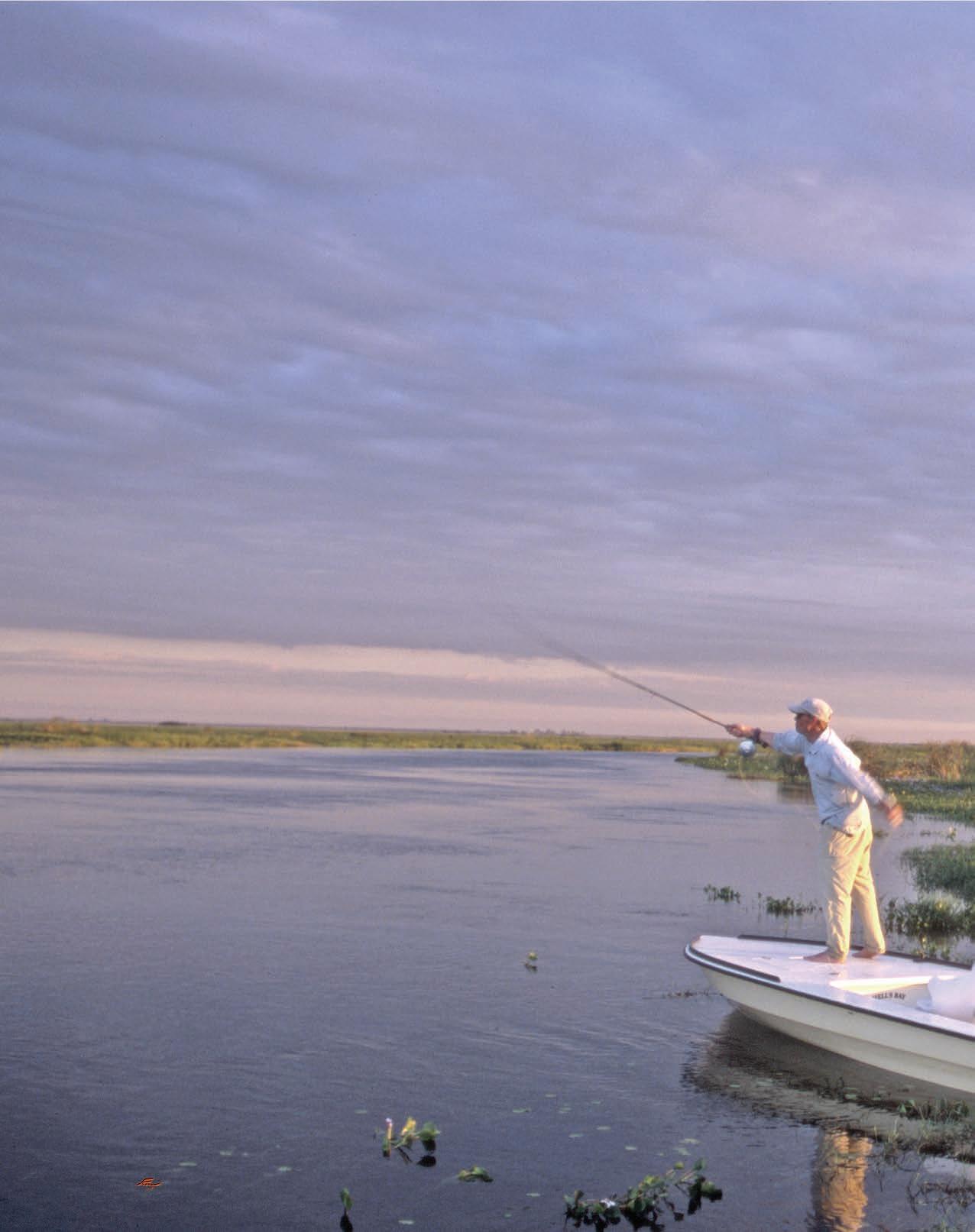
Dorado are exceptionally strong and range in size from 5 to 50 pounds, with the world record being 70 pounds. These aren’t just big fish, they’re voracious creatures that hammer streamers and attack topwater flies with reckless abandon.
The strike of a dorado is unbelievably violent, and is immediately followed by a relentless series of line-stripping runs and explosive, acrobatic leaps. Broken rods are common, and the fish can literally rip the rod right out of your hands.
Dorado are migratory, spending their entire life in freshwater, either spawning or chasing migratory baitfish called sabalo, which are roughly the size of a small American Shad. The best months for dorado at Pirá are December through April. By the time the southern hemisphere autumn arrives in May, the water is too cool and the fish are less active. You can still catch a few fish, but as April stretches into May, the more common top water action of the peak season (January through March) gives way to sink tip lines and less active fish.
pirá lodge is located on the shores of the The Iberá Wetlands Nature Reserve, the second largest wetland on Earth, with more than three million acres of flowing water where rivers and marshlands converge. The Iberá Wetlands is essentially unexplored and uninhabited, and home to more than 350 species of birds and 85 species of mammals.
Pirá Lodge was the first luxury fishing resort to focus on dorado, and they do it exclusively with flies! Pirá anglers fish dorado from Hell’s Bay flats skiffs, ideal for the marsh environment and fly rodders. Guides are well-trained, and food at Pirá is absolutely first-class.
Built with exquisite Corrientes style and pride, Pirá Lodge enjoys a spectacular panoramic view of the vast wetlands. It accommodates up to 10 guests in five deluxe rooms, each with a private entrance, private bath, two double beds, ceiling fans, and air conditioning. A separate building, attached by covered walkways and open-air patios, accommodates the spacious living room, bar, and dining areas – each with tall doors that open to the wide veranda. Pirá Lodge was designed by award-winning architects to respect traditional regional elegance – offering all of the comforts and luxuries of a contemporary boutique hotel. Relax and enjoy a cocktail at any hour, and cool off in the outdoor swimming pool after a rewarding day of fishing.
The warm, sub-tropical climate of northern Argentina makes Pirá a wonderful mid-winter destination that dovetails with the peak fishing season in Chile, and the best of the fishing and shooting season in Argentina.

s 7 nights/6 days guide fishing $7,450
s 6 nights/5 days guide fishing 6,850
s 5 nights/4 days guide fishing 5,750
s 4 nights/3 days guide fishing 4,650
s 3 nights/2 days guide fishing 3,550
s Non-angling rate is $650 per night per person Packages include all meals, open bar, guided fishing and loaner equipment.
The birthplace of the passion, fever, and enthusiasm fueling the sport of dorado fishing is Argentina, and Ricardo “Pinti” Pinto is the most famous dorado outfitter in Latin America. He’s forgotten more about dorado than most claim to know, and has a small, riverside lodge in a village on the shore of the Paraná River, perfectly positioned to access the endless river, back bays, and side channels that hold some of the largest dorado in the world!
FROM HIS ITÁIBATÉ base on the Upper Paraná River below Yacyretá Dam, Ricardo Pinto and his expert staff of fly fishing guides are perfectly positioned to pursue some of the largest and most explosive freshwater carnivores in all of South America.
The river in this region is a tailwater for more than 70 kilometers. The water can have over 6 feet of visibility, and the dorado in this area cohabit with exceptionally large pacu that range from 8 to 25 pounds, and pirá pitá which are called “Paraná Salmon” because of their red meat.
Pinti and his guide staff are world-class professionals, with decades of experience, fishing and guiding dorado all over South America. These guys are considered the best in the business, and have developed the most popular flies and the most effective techniques used in this aspect of the sport. They are terrific communicators, coaches, and fun to spend a day on the skiff with. They’ll fast-track you on the fly fishing tactics needed to become a successful dorado angler, and you’ll learn something new every day. Guests fishing with Dorados on the Fly are accommodated in a very well-appointed and spacious traditional Argentina-style lodge sitting right on the banks of the Paraná River, with spectacular views of the water and jungle environment surrounding this amazing fishery. Anglers are accommodated in large single/private rooms complete with en suite bathroom, air conditioning and all the amenities you would expect in a first-class fishing lodge. Meals are enjoyed in the main dining room, and fish stories are shared in the full bar.
The best months for dorado fishing on the Paraná River with Dorados on the Fly is from October through early January, and again late March through May.

From late January through February and early March, the waters become warm and the dorado tend to be off the bite. However, this is prime time for fishing pacu and pirá pitá on dry flies – technical sight fishing with lighter gear (5 and 7 weights). During these months, we fish for dorado early in the morning and late in the evening.
Dorados on the Fly operates for the majority of the year, September 1 through May 31.
Pinti’s place features lovely guest rooms, fine meals, great wines, and a full bar. Anglers share a guide and boat in search of trophy dorado on the Upper Paraná River using sinking tips or floating lines.
s 7 night/6 day fishing package $6,200 per person
s 6 night/5 day fishing package 5,300 per person
s 5 night/4 day fishing package 4,400 per person

s 4 night/3 day fishing package 3,300 per person
Packages include all meals, open bar, guided fishing, round-trip ground transportation from Corrientes or Resistencia, professional daily guided fishing, fishing license and laundry service.

SOMETHINGWONDERFULLY unique to the majority of the jungle fishing destinations that we represent in Bolivia, Brazil and Colombia, is their transparent and equitable partnership with local indigenous communities that allow our outfitters to operate in their territories. These collaborative partnerships promote sustainability, conservation and culture.
The model for these programs was the brainchild of Untamed Angling, and started with their three Tsimane lodges in the Bolivian jungle. In addition to the cost of the trip, anglers are required to pay a native fee of which 100% of the proceeds as well as 50% of the net profits of the trip is given to the local communities. Those funds have been used to provide medical care to local communities, vaccinations, wellness checks, prenatal healthcare, preventative medicine as well as trauma and emergency care. It has improved the natives quality of life, and built a sustainable future for the indigenous communities that own their territories.
Since its inception, Untamed Angling in Bolivia has provided annual employment to more than 300 indigenous and 100 nonindigenous locals.
The funds you provide through your native fee help natives preserve their culture and tradition, while also preserving their territory and providing more economic benefits for indigenous peoples than any other tourism project in Latin America.
Native fees fund park rangers, conservation projects, studies on environmental biodiversity and species as well as implementing safe handling of inorganic waste – all in an effort to maintain a balanced and healthy environment.
Untamed Angling used the same model when developing their Brazilian fisheries at Rio Marie, Kendjam, Pirarucu and Xingu. Native fees in Brazil, in addition to providing medical care, help fund education, conservation initiatives, and modern communication systems. For the Kayapó Nation’s operations –Kendjam and Xingu – indigenous fees have been used to purchase laptop computers which tribal members use to help spread the word of the ongoing threat to their native territory.

Their successful blueprint has been adopted by our partners in Colombia at Afloat with their programs on the Tomo River and Colombia Pesca, and the Mataveni River.
Thank you for your contributions and continued support, you are making a difference.
A portion of your dollars are making a difference in native lives, and improving the understanding and conservation of their territories and native species.Val Atkinson photo Eric Ersch photo Pat Ford photo
THEELABORATE body paintings so many anglers have seen or experienced firsthand are a rite of passage at our Brazilian destinations, Kendjam and Xingu. They are a unique component of the experience, and deeply rooted in the Kayapó Nation – the guardians of the jungle.
According to the Kayapós, it was Kuben-Nhepre (the spirit of a bat) that introduced them to the body painting ritual, one of the most symbolic hallmarks of the Kayapó. The Kayapó, first and foremost, are jungle warriors (people of the headwaters), and for decades have fought to protect their territory from continuous waves of loggers, miners, slash and burn farmers, ranchers, and land thieves.
The body paintings give the Kayapó spiritual protection of their bodies from external forces, from the moment of birth until death. The paintings are also a sign of beauty and used in important ceremonies, like namings and weddings, as well as fishing and hunting expeditions. Interestingly, only Kayapó women, shamans of their culture with deep connections to the spirits, are allowed to body paint.
The body paintings come in two colors, red and black. Red dye is made from Urucum fruit seed (Annatto seed), mixed with extracted native palm tree oil. Red is an expression of vitality, humanity, beauty, well-being and keeps the soul attached to the body. As soon as a Kayapó child is born they are adorned with red dye, applied by women in wide stripes across the entire body.

The black dye comes from the mixture of extracted Jenipapo fruit mixed with black charcoal powder derived from tree bark. The black painting is powerful protection against the spirits of the dead and animals, and blocks evil spirits from penetrating the body. Black body paintings act as a shield in preparation for war, hunting and fishing. It makes warriors braver, stronger and more agile.
The different intricate black line paintings are usually applied with fingers or thin, flexible wooden sticks and have many different meanings. Some represent animals like a turtle shell to give protection in a hunt or war, and others are the more geometrically freehand that may represent the skin of a snake or jaguar. The more elaborate the drawings, the more status and preparedness you have in the village. Solid black painting is for the youth who are not yet prepared for manhood.
Anglers that visit Kendjam or Xingu are encouraged to participate in the body painting. It’s part of the jungle experience and a terrific opportunity to honor our Kayapó hosts.
Article contributed by Rodrigo M. Salles – Untamed Angling
DISCOVERYOF the Mnyera and Ruhudji river systems in Tanzania a decade ago was nothing less than a milestone in our sport when one considers that, in the previous half-century fly fisherman had been targeting tigerfish, no twenty-pounders had ever been landed. Then eight fish over that mark were landed in as many days on the Mnyera!

The Fly Shop’s well-established outfitter and travel partner, African Waters, pioneered angling in this part of East Africa. They discovered the potential of these two magnificent fisheries, then teamed up with the hunting operator who holds the exclusive concession to this massive Tanzania jungle wilderness.
Unlike other famous tigerfish fisheries, this outfitter is allowed to strictly limit river traffic and enforce year-round anti-poaching regulations. The result is that during each of the ten years since these two river camps were developed, every aspect of the operation, and the fishing, has continued to improve.
Guests enjoy spacious, traditional, safari-type tent camps with ensuite bathrooms, daily laundry, fine meals, and a staff-to-guest ratio that virtually guarantees personal attention and the great service that has become the hallmark of African Waters.
The Fly Shop’s angling travel team has visited this fabulous fishery several times in the last three years, and has completely vetted the operation. Hands down, it is not only the best tigerfish fishing Africa has to offer, but the destination truly rates as one of the world’s finest and most unique angling experiences.
Because both fisheries are loaded with a startling population of huge, freshwater crocodiles and hippos, there is very little wading done on either the Mnyera and Ruhudji rivers except in their clear, shallow headwaters. Most angling is done from the safe confines of comfortable, shallow-draft jon boats, perfectly suited for these rivers.
These ferocious predators have no equal in freshwater.
The strike of a tigerfish is ultra-violent and every non-stop, finger-shredding battle is punctuated by a breathtaking display of gravity-defying leaps.African Waters photos “Notice the cockpit surrounding the boat man is sitting in. The elevated gunnels have been designed to keep the boat man low in the boat while anglers are casting, and keeps the crocodiles out!”
Fly fishermen tempt these toothy savages with streamers or poppers tossed toward cutbanks or structure where the fierce predators might lie in ambush. Fish range in size from 5 to 25 pounds. Most of the largest fish are lost, because these critters don’t just look ferocious, they battle like no other fish found in freshwater, combining aerobatics with blistering runs that peel a full fly line off the deck in seconds.
This place has all the sights and experiences that you might expect in the African bush. Hippos and herds of buffalo and elephant are common in the area, as well as a host of plains game species including puku, warthog, hartebeest, zebra, eland, bushbuck, and the occasional sighting of lions and leopards. The amount of bird life is exceptional, with many rare and endemic species sighted in the area.
“My first big tigerfish burned through the leather on my Sun Glove, the tape on both stripping fingers, and nearly cut me to the bone.”
Justin Miller – Mnyera, 9/15/19THEBESTTIME to be there is from August thru midNovember, when the annual dry season causes the water temperatures to rise, the clarity to improve, the baitfish population to explode, and tigerfish to go berserk. The short season is timed to ensure predictably good weather, and is limited to only eight guests weekly. It is a strict catch-and-release operation with a well-managed system that keeps each of the beats fresh and provides season-long, non-stop action.
This East African angling safari is a walk on what is unquestionably the wildest side of fly fishing! Tigerfish in the nearly clear headwaters of these two, broad, shallow rivers share the riverine landscape with savage crocodiles and grumpy hippos, but no one else!
The Fly Shop® couldn’t give this action-packed trip a higher recommendation. The journey begins and ends with overnights in Dar es Salaam, adding 2 days to the length of the trip. Airport/hotel transfers and round-trip charter flights to the camps are included. International airfare, hotel overnights in the city, and Tanzania’s $100 visa are not part of the package.
Four of the eight fly fishermen in each group spend half the week ( 3 full days ) at each of the two well-equipped, fully-staffed river camps. They exchange locations mid-week, joining up the last night at the larger ( Mnyera ) camp, before returning on the final morning’s two hour charter flight to Dar es Salaam.
One of the many highlights of African Water’s Tanzania Trophy Tigerfish adventure is the mid-week transfer day between Dhala Camp (Mnyera River) and Amaki Camp (Ruhudji River ). This amazing Range Rover journey exposes the full splendor of the African bush with sightings of cape buffalo, bushbucks, warthogs, hartebeest, zebra, eland, the occasional lion and a landscape unchanged for thousands of years. It’s a miniature classic African Safari, and certainly warrants a camera and good set of binoculars s 7 night/6 day package $11,400 Includes Dar es Salaam charter flights

GAMEVIEWINGOPPORTUNITIES are a great way to extend your angling holiday in East Africa. The period from September through to November is an excellent time to embark on a game viewing safari in Tanzania, with special attention given to the Serengeti and Ruaha National Parks. This time of year is considered the shoulder season, offering a unique and favorable combination of wildlife experiences and weather conditions.
GREATMIGRATIONINTHESERENGETI : September is when the annual Great Migration reaches its peak in the Serengeti. Millions of wildebeests, zebras, and other herbivores move in search of greener pastures, creating one of the most extraordinary wildlife spectacles on the planet. Witnessing the dramatic river crossings as these animals face crocodiles and other predators is a highlight of the safari experience.
LESSCROWDED : Compared to the high season from June to August, the period from September to November sees fewer tourists in both the Serengeti and Ruaha National Parks. This means more intimate wildlife encounters and less competition for prime game viewing spots, allowing visitors to enjoy a more tranquil and immersive safari experience.
MILDWEATHER : During this time of the year, Tanzania experiences its dry season, characterized by mild temperatures and clear skies. The weather is generally pleasant, with warm days and cool nights, making it comfortable for game drives and other safari activities.
ABUNDANTWILDLIFE : The dry season concentrates wildlife around water sources, such as rivers and waterholes, which increases the chances of spotting various animals, including lions, elephants, giraffes, and more. In Ruaha National Park, the riverbanks become a hub for wildlife activity, and you can observe large herds of elephants and other animals.
BIRDWATCHINGOPPORTUNITIES : September through November is also an excellent time for birdwatching in Tanzania. Many migratory bird species arrive during this time, adding to the diversity of the avian population.
PHOTOGRAPHICOPPORTUNITIES : With the landscapes turning dry and golden, the lighting conditions become ideal for photography. The stunning sunrises and sunsets in the Serengeti and Ruaha provide fantastic opportunities to capture breathtaking images of the wildlife and scenery.
Autumn is a remarkable time to visit Tanzania for a game viewing safari, especially in the Serengeti and Ruaha National Parks. You'll have the chance to witness the awe-inspiring Great Migration, enjoy less crowded safaris, experience mild weather, encounter abundant wildlife, and take advantage of excellent photographic opportunities. It’s a period that promises unforgettable memories and an unparalleled connection with nature and wildlife.

Fishing the Faro River for the absolutely enormous Nile Perch, in Africa’s Cameroon, may very well be the most wild and unique adventure offered by The Fly Shop®, on this entire planet. This trip is truly a full on leap into the African bush, living and fully immersing yourself in a wild safari.
WHEN YOU HEAR someone mention perch, trophy fishing doesn’t exactly come to mind…but in Africa, nothing could be further from the truth! The Nile Perch that you will be targeting have proportions that are so extreme that they are hard to comprehend. These beasts reach massive dimensions, exceeding 200 pounds, dwarfing any other fish that you can imagine in freshwater, besides maybe an arapaima. They do come in all sizes though, and it is best if you warm up on a few of the 30 to 60 pound models, before you jump right into a jumbo, but you may not get that choice!
On top of the Nile Perch, you will also encounter ferocious tigerfish and large finicky yellowfish to keep you busy while you hunt giants. Both species are amazing targets on the fly, both boasting separate destinations dedicated entirely to their own pursuit. Cameroon’s Gassa Camp is Africa’s only destination to target the top 3 freshwater species of Africa in one location.
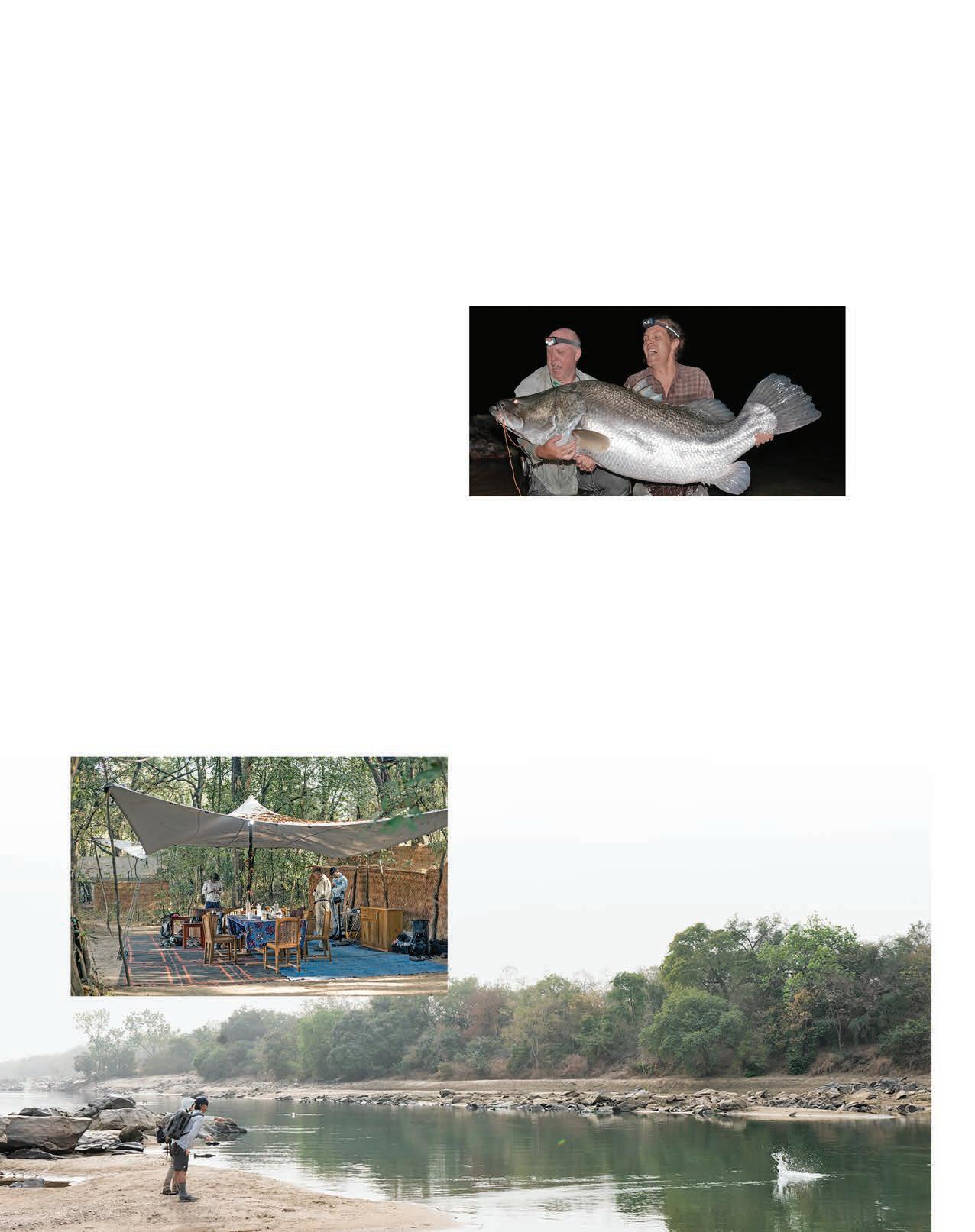
To get here, guests will fly into Douala, Cameroon and overnight. The next morning all anglers will fly to Garoua, a 2 hour commercial flight included in the price, then drive a 4 hour ground transfer into Gassa camp, a seasonal tented camp situated in the deep shade of a mature forest on the bank overlooking the Faro River. The camp sits right in the middle of a 2,000 hectare private concession, the perfect base from which to access the fertile waters of the Faro, and enjoy a classic West African Safari experience.
Gassa Camp accommodates only 4 anglers per week in single occupancy meru tents, each with a private view of the Faro River. The central living area is the heart of the camp and is made up of a 8m x 6m Bedouin tent, under which is a comfy lounge and dining area. There is an open air fireplace around which drinks and stories are shared each evening, and coffee is poured each morning while listening to the sounds of the awakening African bush.
The river is impossible to navigate by boat in this section of water that runs over and through hard bedrock. Therefore, all fishing is done on foot, wet wading and casting from the rocks. Additionally, the majority of the fishing is done at night, when Nile Perch are most active, so you definitely need to be mobile in order to fish in this rough terrain, on your own two feet.
The best time to be there is from January through March, when the annual dry season causes the water to drop into the channels between the bedrock, water temps rise a bit, and the clarity of the river improves. This allows you to get as close as you can to these river monsters, giving your fly a chance to get down in front of the fish of your dreams. The short season is timed to ensure predictably good weather, and is limited to only four anglers per week. This is a strict catch-and-release operation. s 7 night/6 day package USD $10,300 Includes commercial flight from Douala to Garoua
FLYINGHALFWAY around the world to a remote jungle fishery in Bolivia, Brazil, Colombia, Argentina or Africa is a major commitment. If you’re going all that distance, why not consider expanding your trip to fully experience and absorb what else a country has to offer. All of our jungle fishing destinations require travel through fascinating cities full of history, culture and captivating sights and events that are remarkably different from what we experience in our everyday lives at home. Expanding your fishing holiday to include a few days in a country is a chance to connect with different people, and expand your understanding and appreciation of the world.
A fascinating and bustling city, located on the banks of the Rio Negro, 900 miles inland from the Atlantic Ocean. Manaus is the capital of Amazonas, the gateway to the Amazon Jungle, rich in history and jungle culture. Anglers traveling to any of our Brazilian fisheries usually spend at least one night in Manaus before heading out to fish, and adding a night or two in this fascinating city is highly recommended. Our outfitters can help arrange day tours to a number of sights including the Meeting of the Waters, where the black waters of the Negro River meet the brown waters of the Solimoes River, forming the Amazon proper. The Mercado Adolpho Lisboa, founded in 1882, is the city’s oldest marketplace where fish, fruit, vegetables and just about everything that comes from the jungle is traded. It is a captivating experience, not to be missed. Another highlight in Manaus is the Amazon Theater, an opera house built in 1884 by the rubber barons, featuring 198 chandeliers and 36,000 mosaic tiles, all accented by Italian Carrarra marble stairs, statues, and columns.

These two cities in Colombia are the jumping off point for our two jungle fisheries, AFloat and the Mataveni. Medellín is the capital of Antioquia Province, a fertile region famous for its coffee plantations and flower farms, orchids and butterflies, and is known as the City of Eternal Spring for its idyllic climate. Bogotá is a bustling city that sits on a plateau at over 8,000 feet. It’s a city rich in 15th-century Spanish culture and architecture with a thriving tourism industry including a modern airport, public transport, international hotels, boutique shopping, green parks and museums, along with fine restaurants, cafés and bars. We highly recommend that anglers consider spending a couple of extra nights in Bogotá or Medellín on the front or back end of their trip to fully appreciate these thriving metropolises, and soak up some of its culture.
The “Paris” of South America, Buenos Aires is a huge cosmopolitan metropolis located on the Río de la Plata at the terminus of the Rio Paraná. Residents of Bueno Aires are called Porteños, which in Spanish means “port city person”. It is by far the most European of Latin America cities in atmosphere, architecture and culture. The chic districts of La Recoleta and Palermo boast some of the finest hotels, restaurants, cafés, parks, museums, and art galleries in South America. It’s the ciudad where tango was born, and where Argentinian First Lady Eva “Evita” Perón waved from her balcony. We highly recommend a night or two in Buenos Aires to discover its allure. To learn more about extending your trip in Buenos Aires, we encourage you to visit our partners at LOL Argentina. These ladies are the best in the business when it comes to tourism and services in Argentina and Uruguay.
It is our experience that add-on cultural adventures are far more enjoyable on the front end of your trip. The obvious benefit of arriving a few days early is that it creates a buffer in case you miss a flight and arrive late, so you won’t miss the bush plane into camp. And, you are also fresh and excited when you arrive at your end destination. Conversely, we tend to find ourselves tired and with a bag full of dirty, smelly clothes and equipment at the end of the fishing trip and are ready to get home and start planning the next adventure.
THETSIMANEPEOPLE live deep in the jungles of Bolivia, where the Andes meet the Amazon, and where the most amazing Golden dorado fishery exists, in the rivers that flow through their villages. Imagine wading in a clear, freestone mountain stream that looks like the McCloud River in NorCal, casting a floating line and streamer to a brilliantly colored golden-reflective predator with razor-sharp teeth and strip setting into 20 pounds of pure muscle that just swam out from behind a boulder to destroy your fly. All hell breaks loose as the golden missile rockets into the air, gills rattling, before he turns his head down towards the rapids and starts a crazed, reel-sizzling run...That’s why you flew 5,000 miles to the remote jungle of Bolivia! Now you’ve got el tigre by the tail and you better have the right gear if you want any chance to land him!
The following fly fishing equipment is what you need to effectively fish for dorado at Tsimane or just about any other dorado fishery:
Fly Rods:
9-foot 8 or 9-weight 4 piece saltwater fly rods. These rods have extra integrity built into them, feature oversized guides, a fighting butt, heavy duty reel seats, and the proper taper to cast big streamers and fight heavy fish.
Fly Reels:
You’ll need a 8 or 9-weight quality saltwater fly reel with a smooth and sealed disk drag, machined from bar stock aluminum, with an easy to adjust and large drag knob.
Reel Backing:
Scientific Anglers XTS Gel Spun Backing is rated at 50-pound test and allows 75% more capacity than standard Dacron.
Fly Lines:
The proper fly lines are critical at Tsimane, as this is what will deliver the 7-inch streamer to your target and ultimately connect you to a trophy dorado.
SA Amplitude Titan/
Jungle Floating Line (a must)
SA Sonar Tropical/
Jungle Intermediate Sink Tip
Leaders & Tippet:
Leaders needed for Tsimane are super simple. Plan on bringing spools of Fluorocarbon tippet in 30 and 40 breaking strengths. Scientific Anglers or RIO knottable wire leader in 30 & 40 pound test. 2 spools of 40lbs!
Flies:
Finally you will want a box of large streamers (4-8 inches), with a few top-water flies thrown in, tied on barbless saltwater hooks 2/0 to 4/0.
Streamers:
3 Andino Deceiver, Black/Purple,3/0
3 Andino Deceiver, Black/Orange,3/0
3 Andino Deceiver, Black/Red,3/0
3 Andino Deceiver, Black/Chartreuse,3/0

4 Major Bunker, 4/0
3 Major Herring, 3/0
3 Mega Cruiser, Black/Purple, 3/0
3 Puglisi’s Boca, Grande Dayglo, 3/0
3 Puglisi’s Boca, Grande Yellow, 3/0
Topwater:
3 Pole Dancer, 3/0
2 PSP Bubblehead, Chartreuse, 4/0
2 Big Boy Trevally Popper, 2/0
The preferred wading set up is shorts over compression fitting running tights - 2 pairs. You will also want to bring 3 or 4 tropical, hooded, long sleeved shirts for fishing and around the lodge. You don’t need to bring a ton of clothes; daily laundry service is provided at Tsimane.
Electrolytes:
Bring Gatorade, EmergenC, Liquid-IV or another electrolyte mix. The jungle is hot and humid, and you will sweat a lot. Water is great, but if you are constantly sweating, you will lose salt and minerals, which will cause cramping. We like to drink three full water bottles mixed with electrolytes – one in the morning, one at lunch and one after fishing. Believe us, this is a game changer.
Jungle ancillary items to bring include:
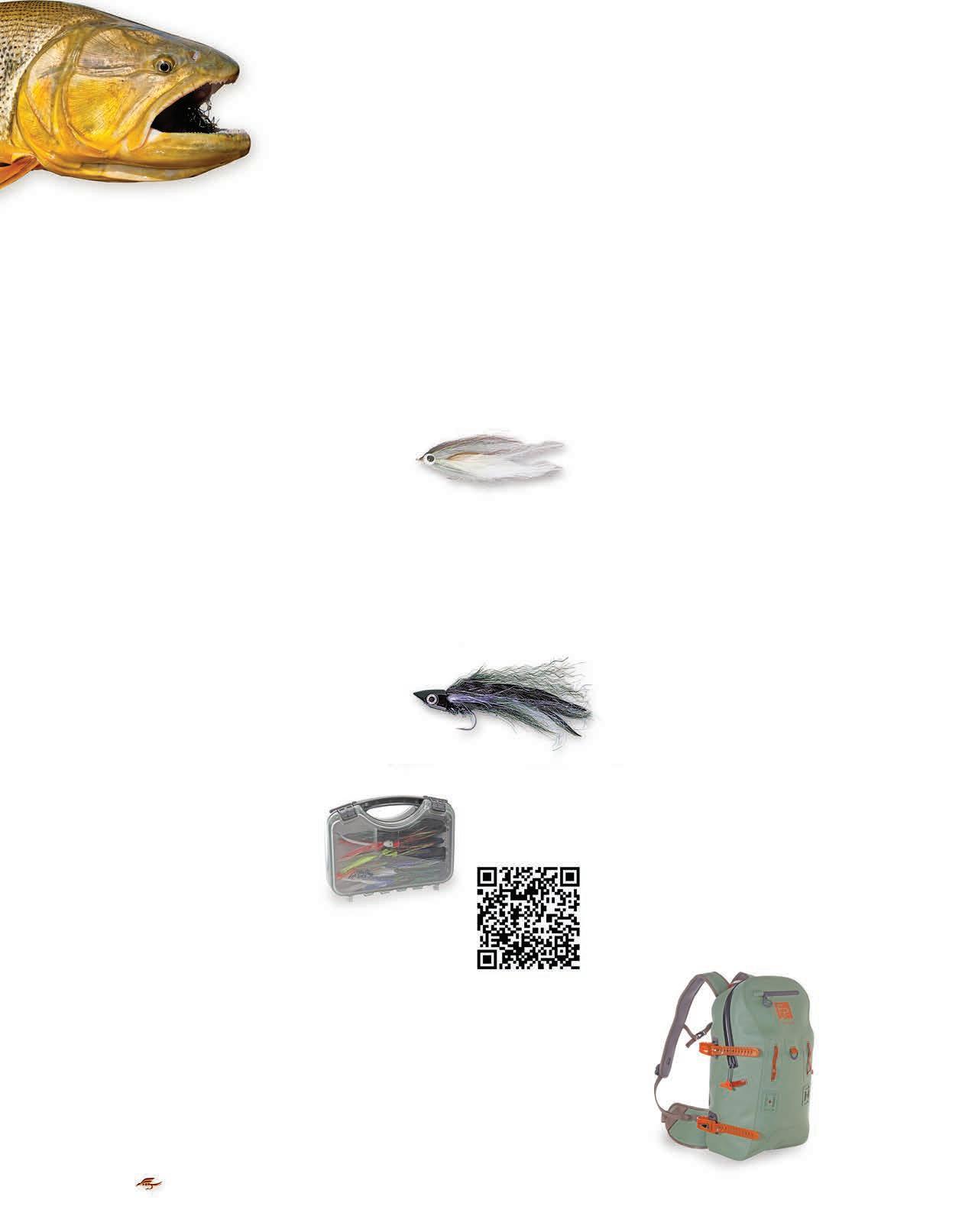
Two pairs of polarized sunglasses (in case you lose or break a pair)
Waterproof sunscreen SPF 30+ (UVA) (UVB) – apply twice a day
Medicated powder – Gold Bond or similar
Anti-itch cream
Lip balm with sunscreen (highest SPF handy)
Pliers
Hook sharpener
Stripping fingers or Flexx_Rap finger tape and fishing-sun protection gloves
Line clippers
Hat with dark under brim
Buff® (bring two)
Lightweight rain jacket and pants
Insect repellent with 30% + DEET
Headlamp
Water bottle
Water bottle and dry Gatorade, Liquid-IV or EmergenC packets
Boat bag (100% waterproof)
Waterproof backpack
Wading Gear:
You’ll be wet wading in rocky freestone rivers all week while fishing at Tsimane, so wading gear is critical, and a pair of sturdy, felt-soled (no studs) wading boots is a must. Plan on bringing two pairs of neoprene socks, and bring a tube of anti-fungal cream and a small bottle of Goldbond medicated powder to keep your feet happy.
PEACOCKBASS are a formidable quarry on a fly rod, especially when they start approaching the 20-pound mark — what we call the gigantes! When hooked, the pull they generate shocks most anglers. We have seen anglers scream or drop their rods from the line burning through their fingers on the initial surge. You will definitely need to hold on tight to your fly rod if you don’t want a dreaded “one that got away” story!
Peacocks are not known for long, sizzling runs, but they will bulldog you right to the end, and test the best fly tackle. This is mano a mano, straight line fly fishing.
The following essential fly fishing equipment is what you need to effectively fish for peacock bass, anywhere that they swim.

Fly Rods:
9-foot rods are by far the best for distance and accuracy, both of which are important on the Marié. 8-weight to 10-weight 4-piece saltwater fly rods are where you need to be for power. These rods have extra integrity built into them, and they feature oversized guides, a fighting butt, heavy-duty reel seats, and the proper taper to cast big streamers and fight heavy fish.
Fly Reels:
You’ll need a quality saltwater fly reel that balances your fly rod. Peacock bass don’t usually take you into the backing; however, a quality saltwater reel with a smooth and sealed disk drag, machined from bar stock aluminum, with a large, easy to adjust drag knob is the way to go.
Reel Backing:
Scientific Anglers XTS Gel Spun Backing is rated at 50-pound test. You get what you pay for with this stuff. It allows for 75% more capacity than standard materials, but we like only having to buy backing once for the life of the reel.
Fly Lines:
Aggressively tapered fly lines, purposely built for the jungle, are what you need. Standard weight forward fly lines will not cut it. You will destroy your arm trying to cast a weighted 4/0 streamer, 800 times a day, with the wrong line. These new integrated shooting tapers have changed the game.
SA Amplitude Titan/ Jungle Floating Line (a must)
SA Sonar Tropical/ Jungle Intermediate Sink Tip
Leaders & Tippet:
50-60 pound Fluorocarbon straight leader material. Heavy leader material is essential in trying to keep a 20-pound peacock bass from pulling you into heavy structure, which is exactly where they will go if you give them an inch. This is one of the only big fish on Earth that the guide won’t yell, “Let him run” after you hook up.
Flies:
Large saltwater streamers tied on heavy-duty hooks (4/0-6/0) are what you want. Streamers with rattles built in are guide favorites. Make sure you have a good variety of sizes, colors and weights.
Clothing:

You need fast drying pants or shorts, the same type of garb you would wear flats fishing. You don’t have to bring a lot of clothing, as there is daily laundry service onboard the Untamed Amazon.
You will also want to bring three or four tropical, long-sleeved shirts for fishing and around the mothership. You don’t need to bring a ton of clothes.
For footwear, a boat shoe with non-skid sole will give you plenty of support and traction on the skiff. Astral Loyaks or Crocs are also a good choice. Be sure to bring a couple pairs of lightweight, lightly-colored socks to protect your feet from the sun.
Luggage:
There is a strictly-enforced 40-pound weight restriction per person for the eight passenger turbo-prop Cessna Caravan flights divided as follows: One 10 pound carry-on piece of luggage and one 30pound checked bag (soft duffel bags with no rigid bottom except for rod cases).
Streamers:
3 Cruiser Peacock, 3/0, 2-5/0
3 Cruiser Sardina, 2/0
3 Mega Cruiser, Yellow/Black, 3/0
3 Cuda Killer, 4/0
3 Bad Attitude Baitfish, Chart/White, 4/0
3 Bad Attitude Baitfish, Orng/Yellow, 4/0
2 Major Bunker, 4/0
Topwater:
2 PSP Bubblehead, Chartreuse-, 4/0
2 Swingers Convention, Firetiger 4/0
2
2
Electrolytes:
Just like at any other jungle or saltwater destination, we strongly suggest you bring powdered Gatorade, EmergenC, Liquid-IV or another electrolyte mix. Fishing in the jungles is hot and humid and you will sweat a lot. Water is great, but if you are constantly sweating, you will lose salt and minerals, which will cause cramping. Drink three full water bottles mixed with electrolytes per day to keep yourself at the top of your game!
Other ancillary items to bring list is same as dorado ancillary items list. See page 46.
800-669-3474 www.theflyshop.com
4140 Churn Creek Road Redding California, 96002
The key to a great fishing trip is planning. It’s that simple. And there’s no one better able to point you in the right direction than the experts here at The Fly Shop®
The 48 pages of this magazine contain the best recommendations and information The Fly Shop® has ever assembled about where and when to go in the jungle, and the proper gear you will need to be successful.

The perfect time to pull the trigger on your jungle fly fishing adventure, is right now. Securing prime dates is always best as soon after the current season as possible.
We’ve been helping fly fishermen with their saltwater travel plans for 45 years. In the process The Fly Shop® has built an unparalleled reputation for honesty, and customer advocacy. You have our word on that.
Visit
this code